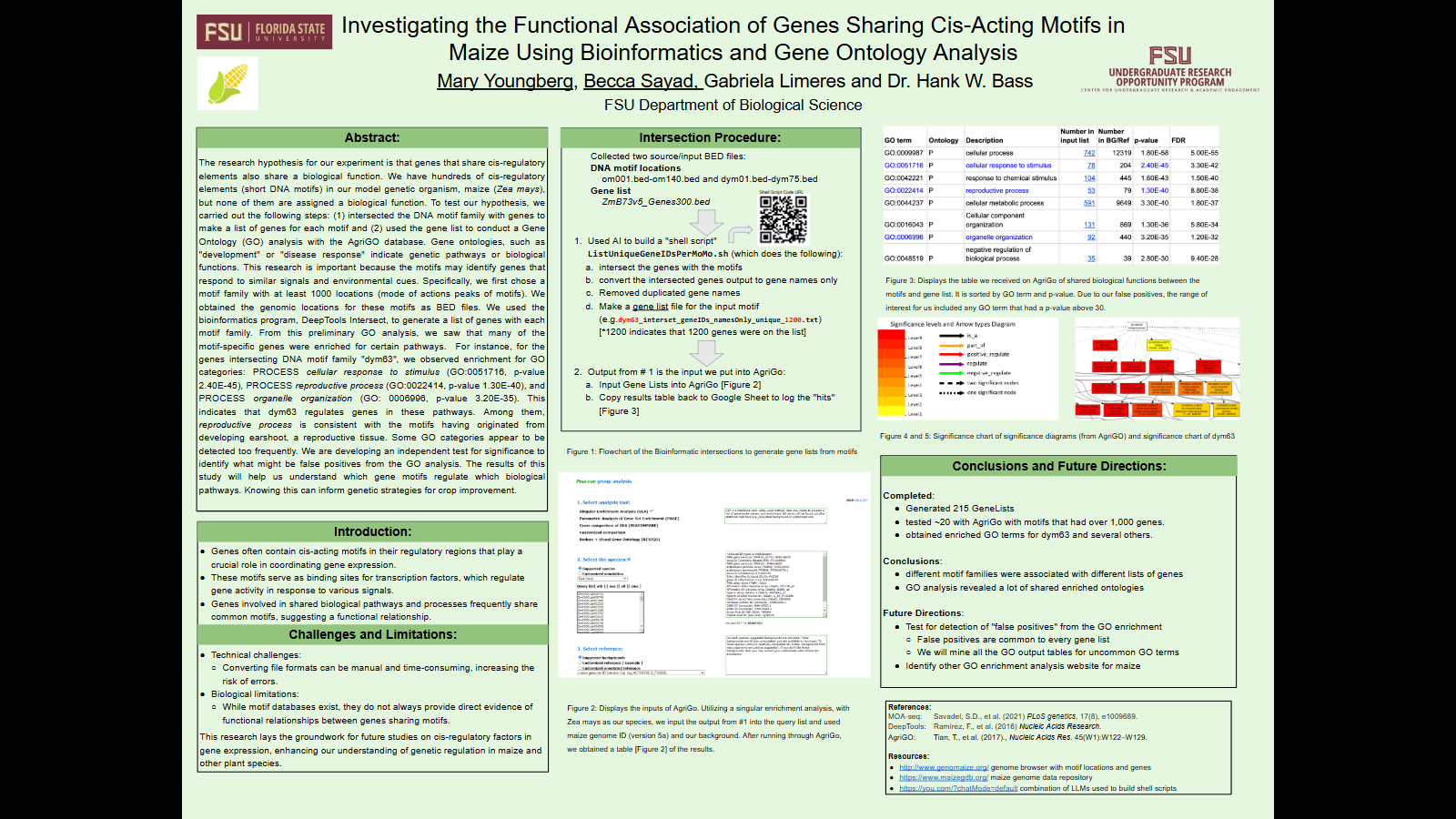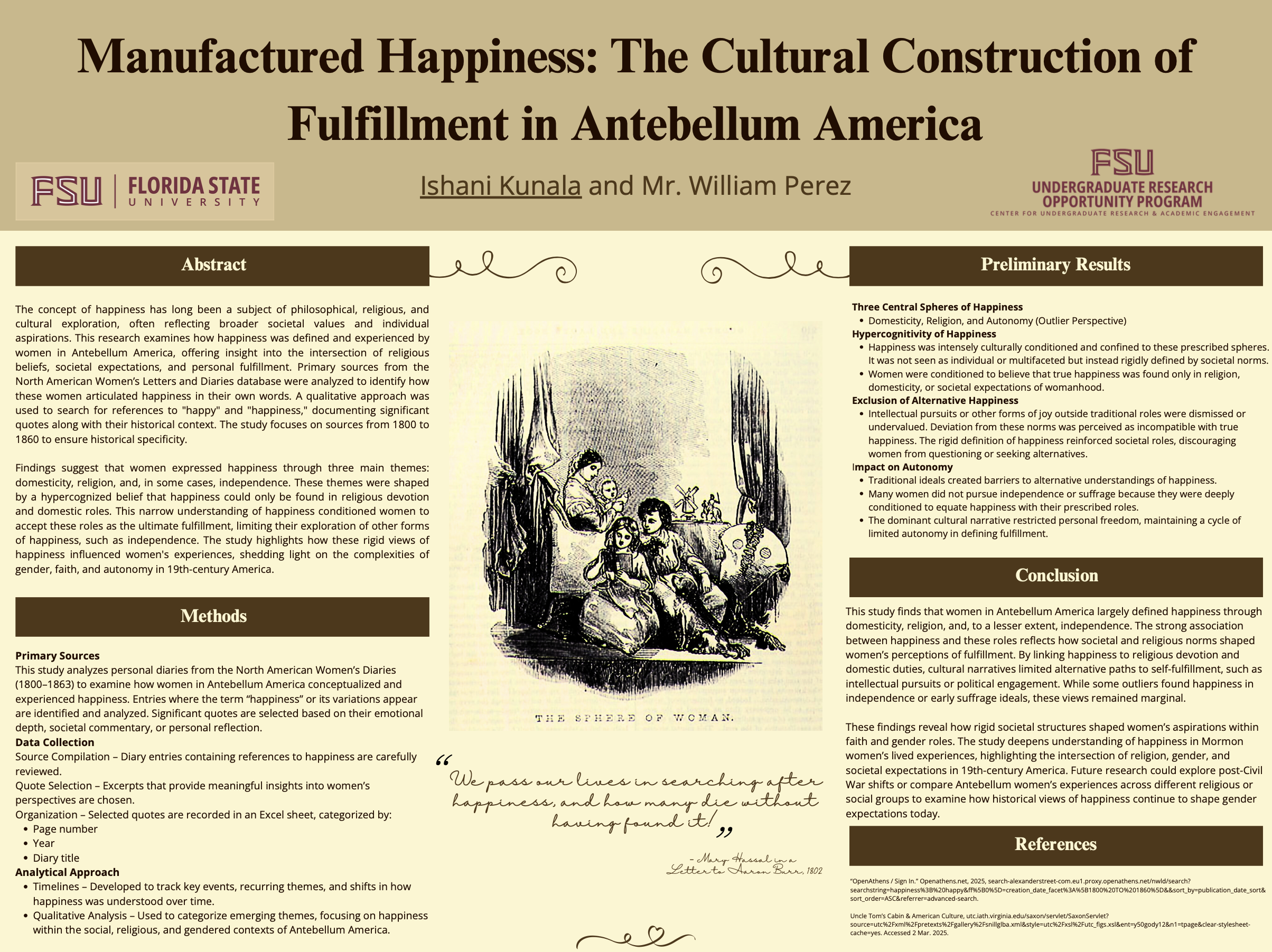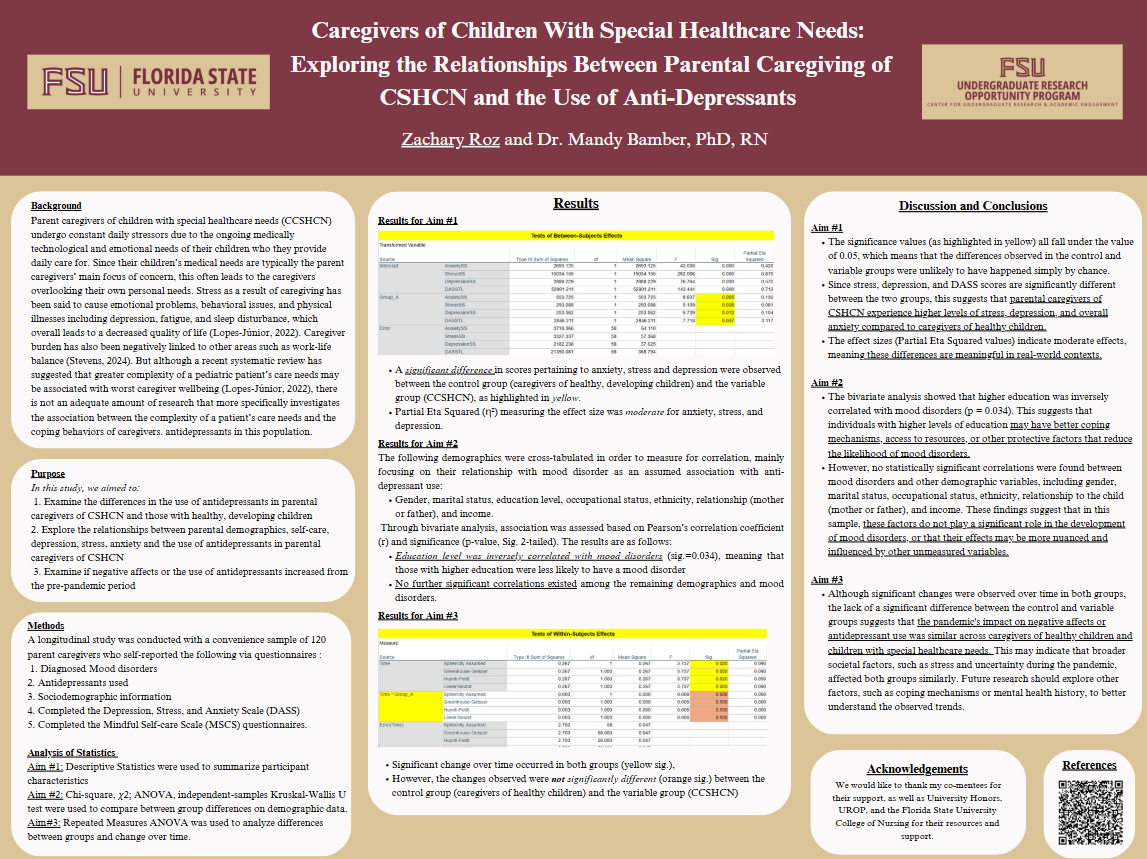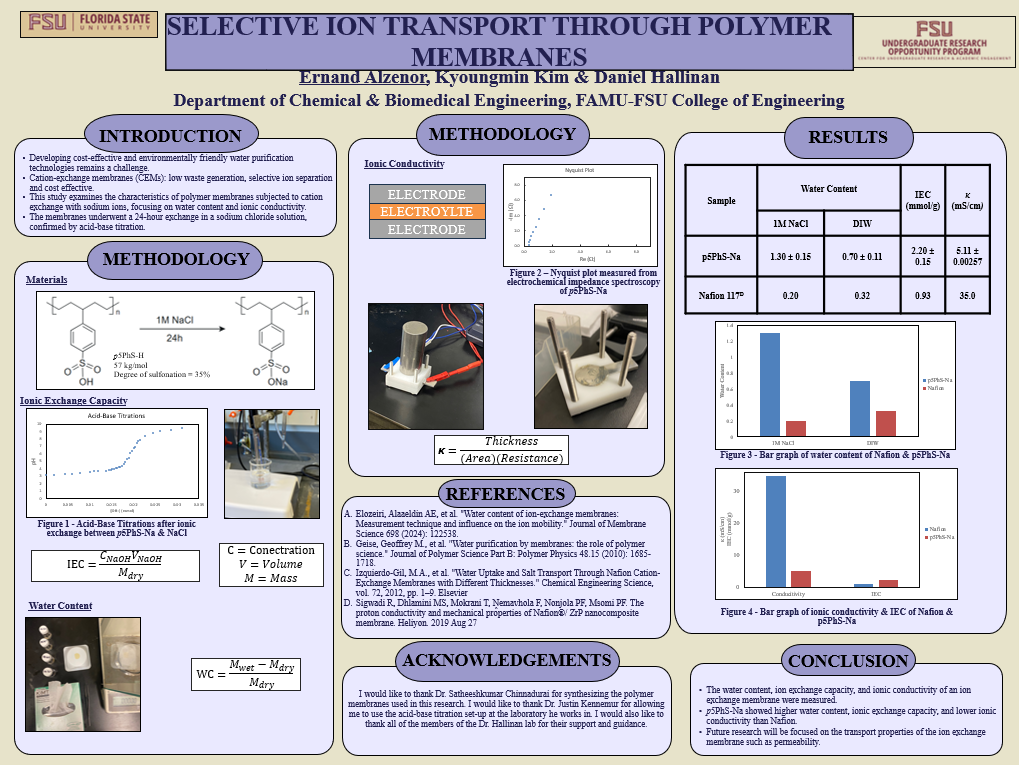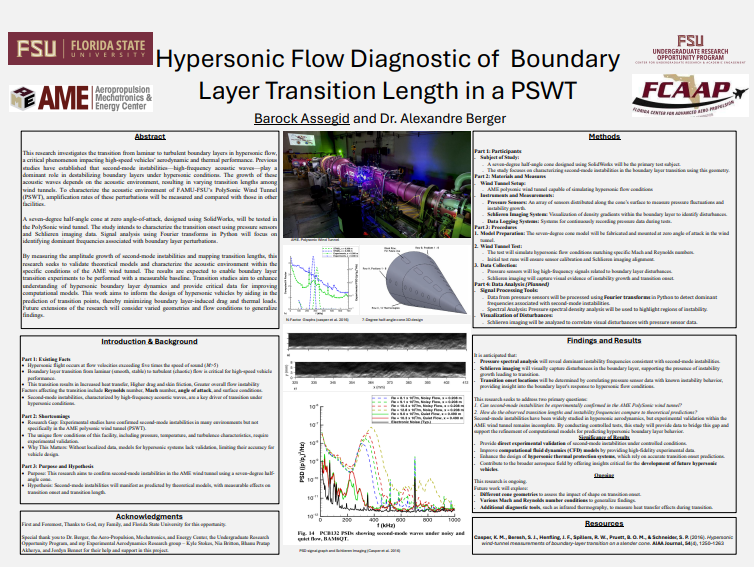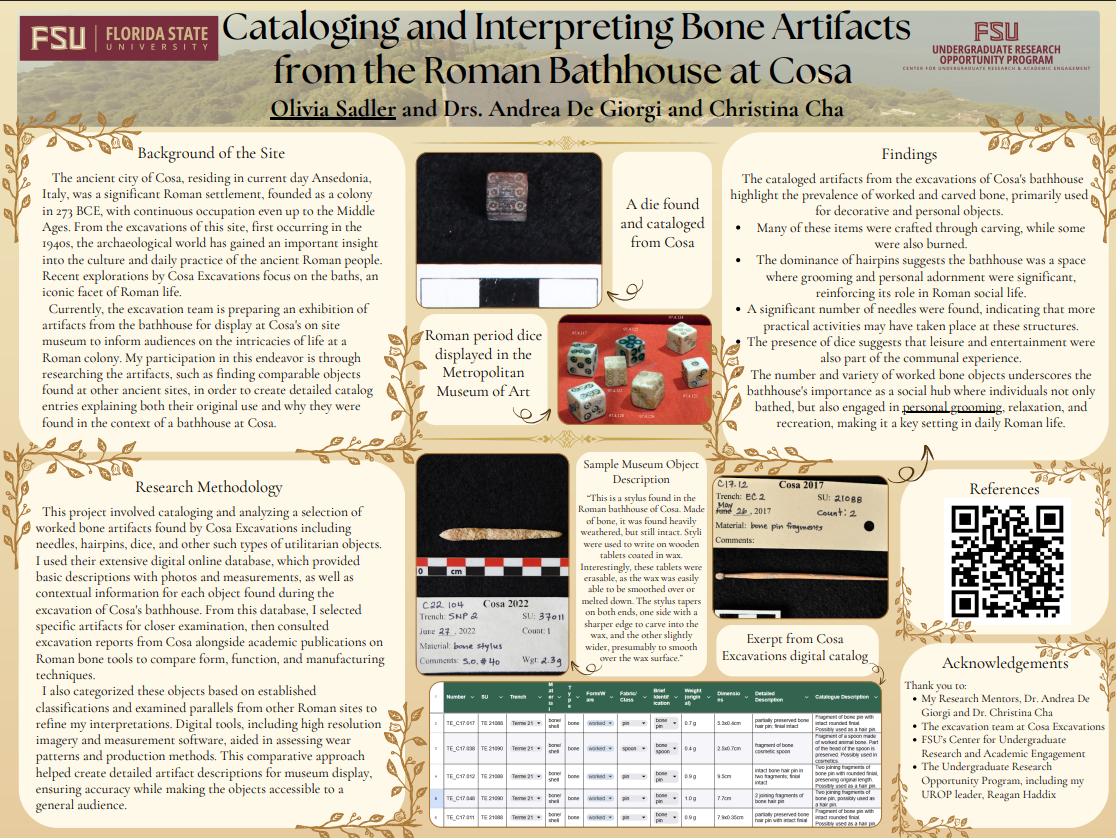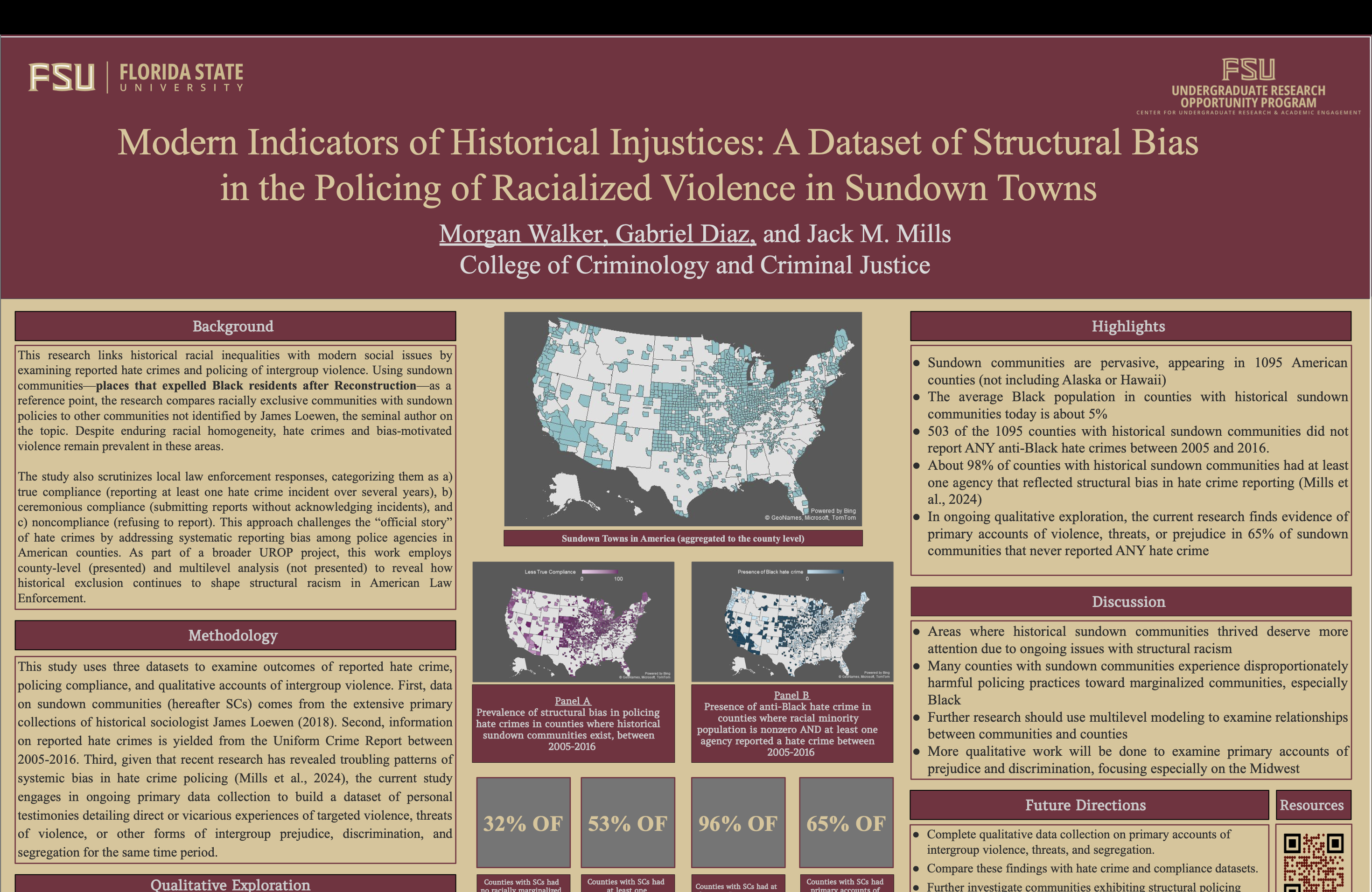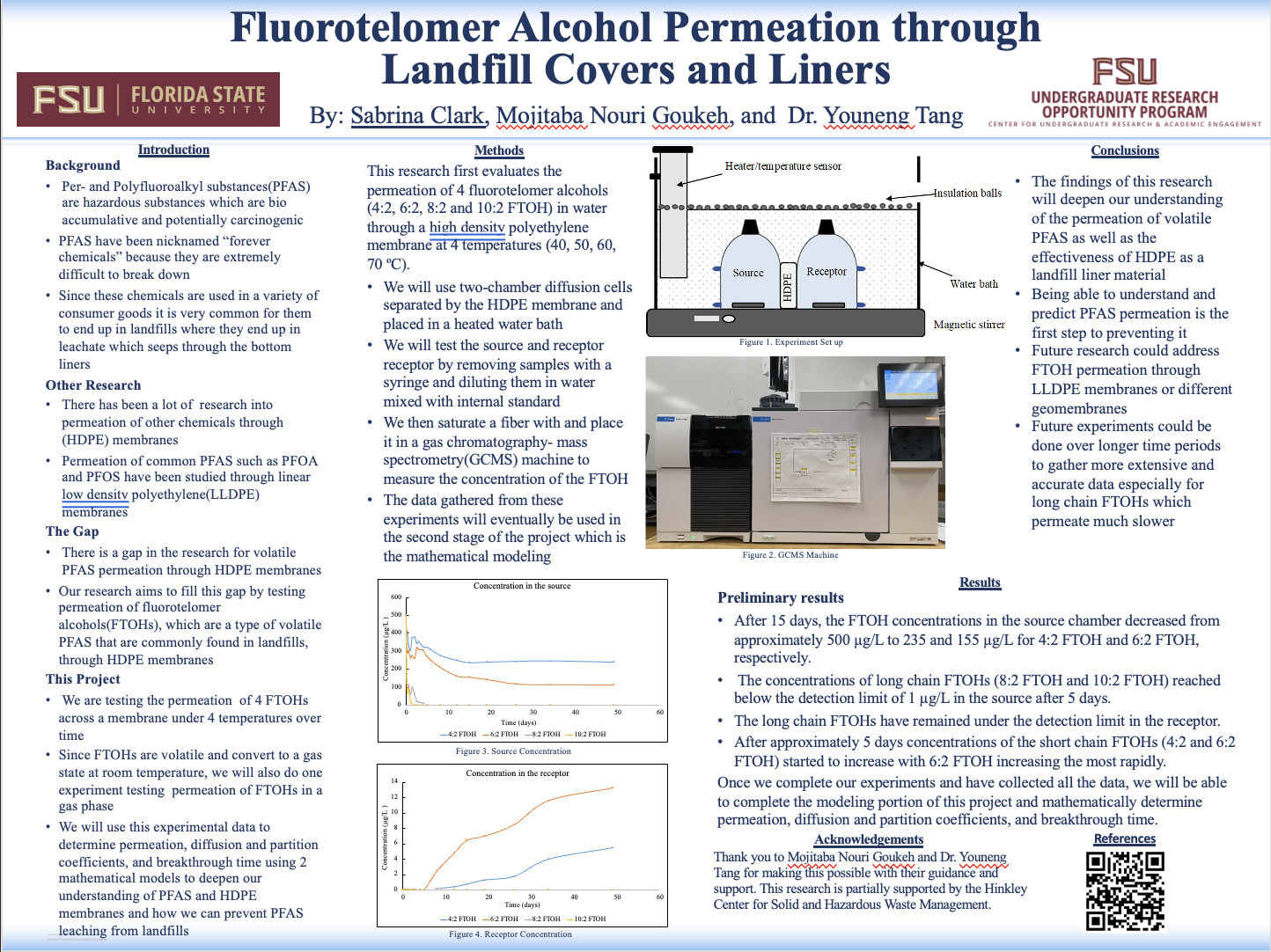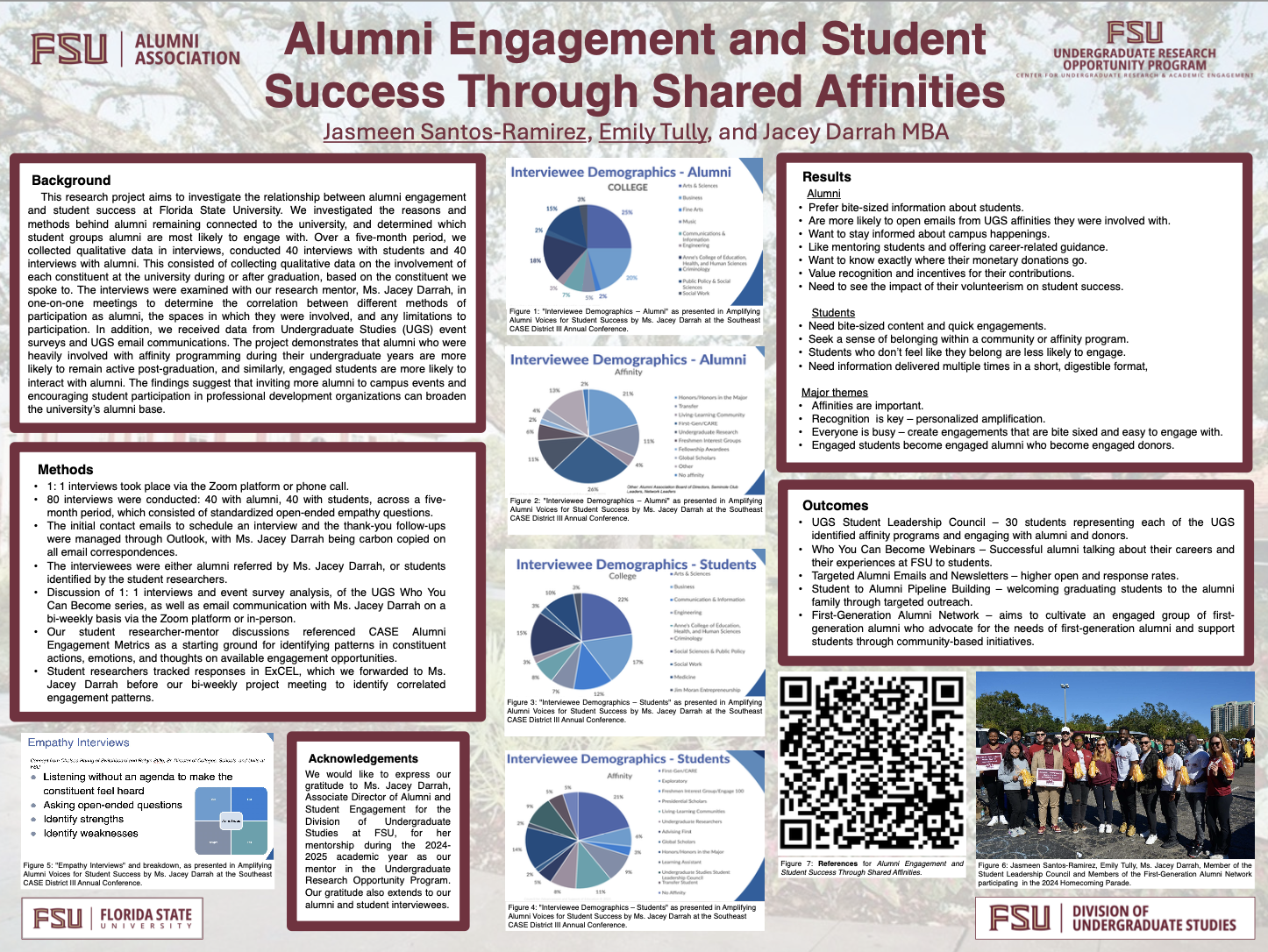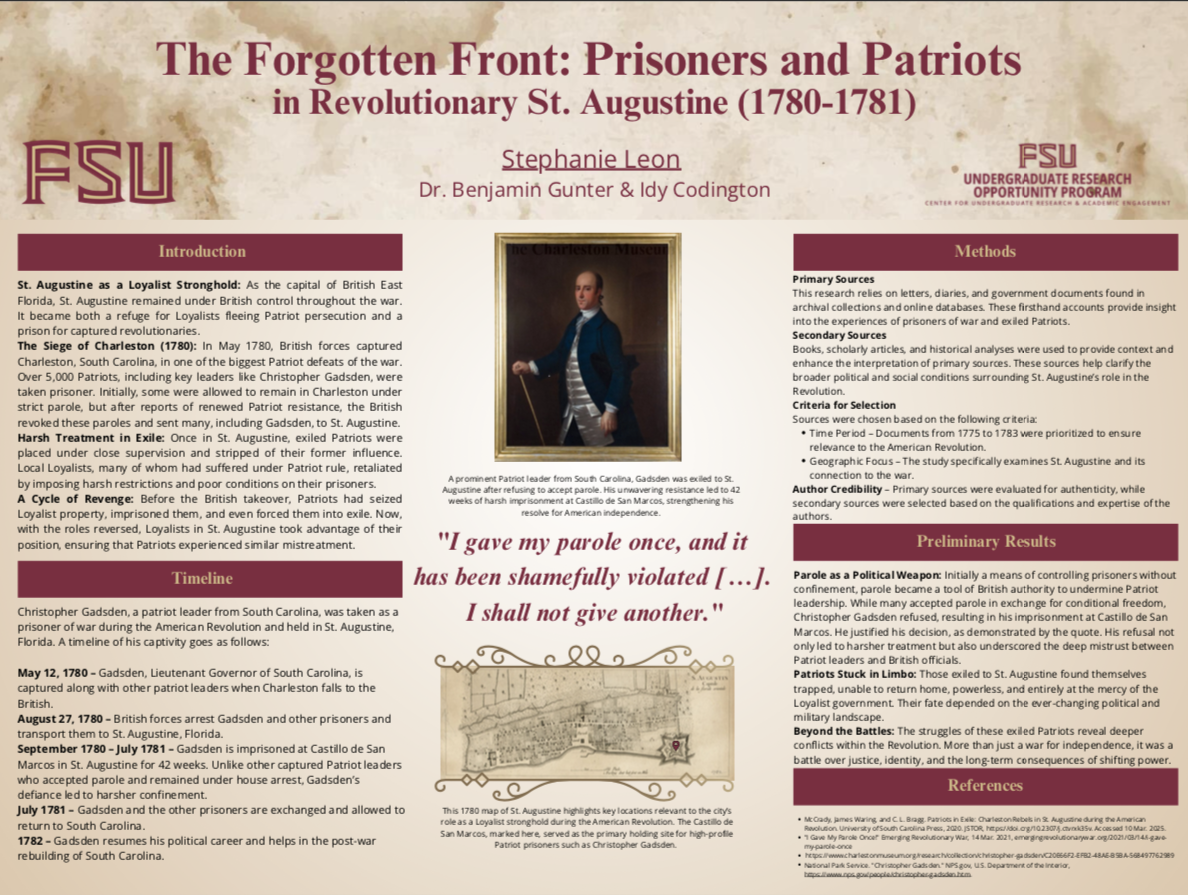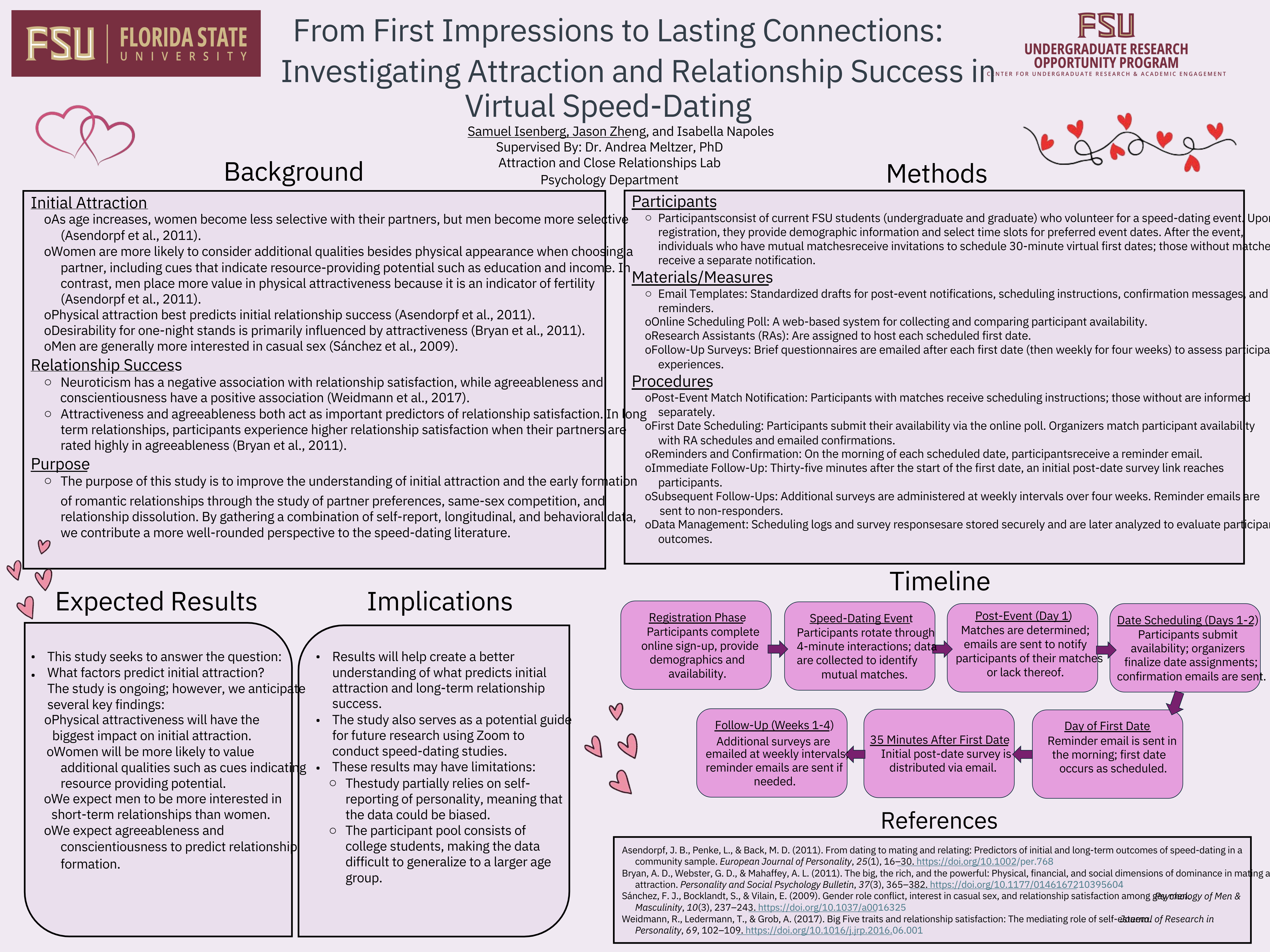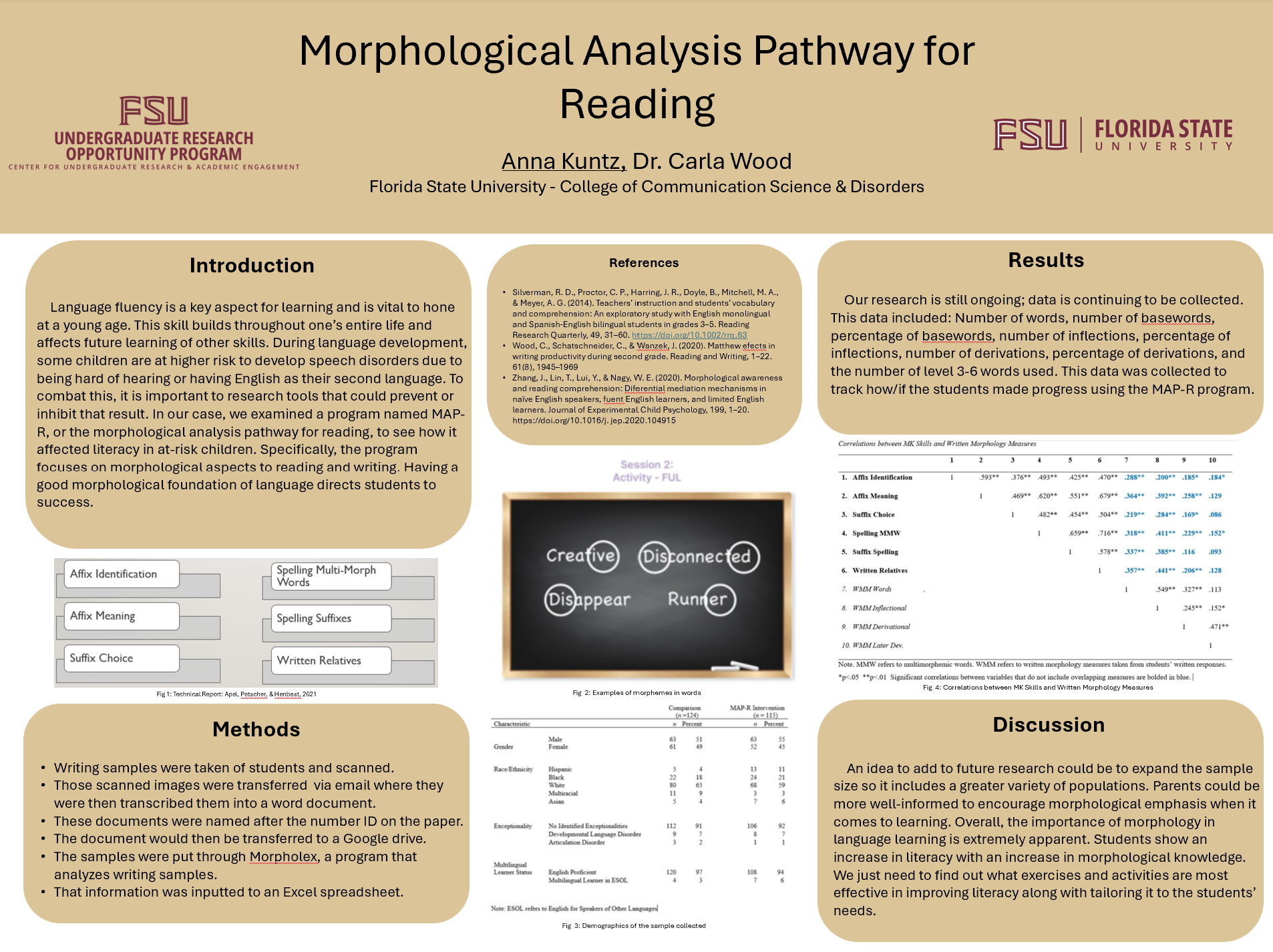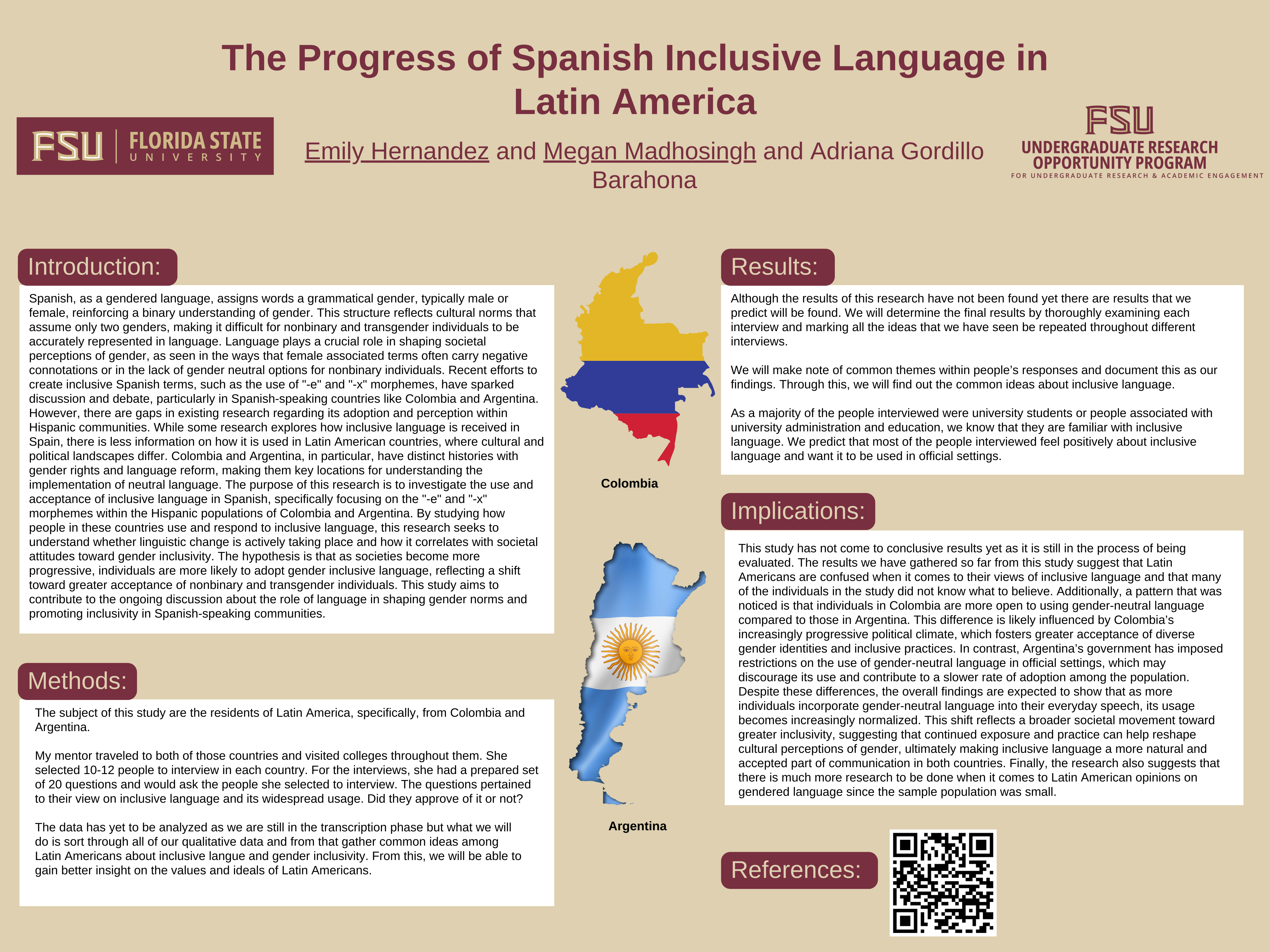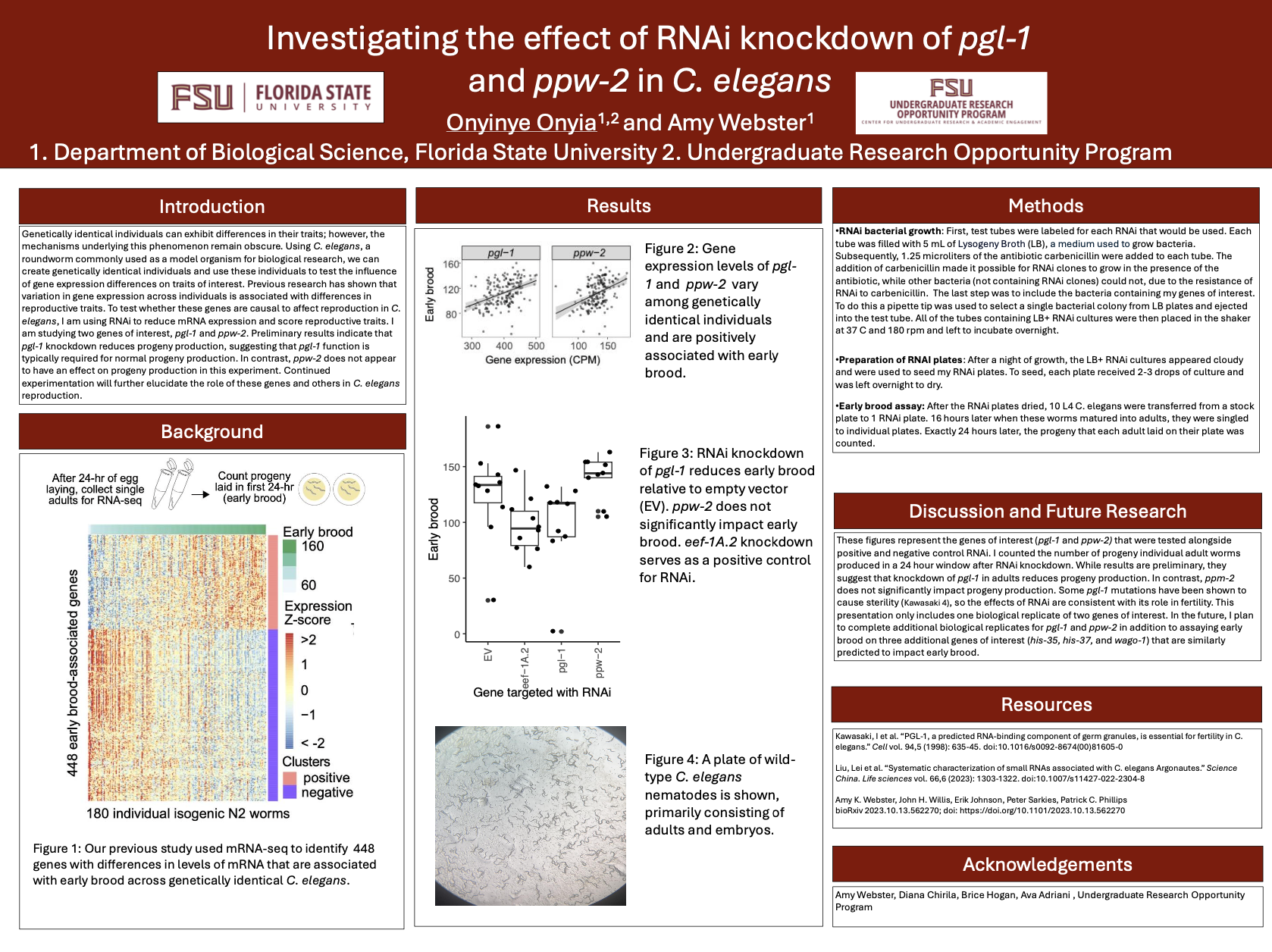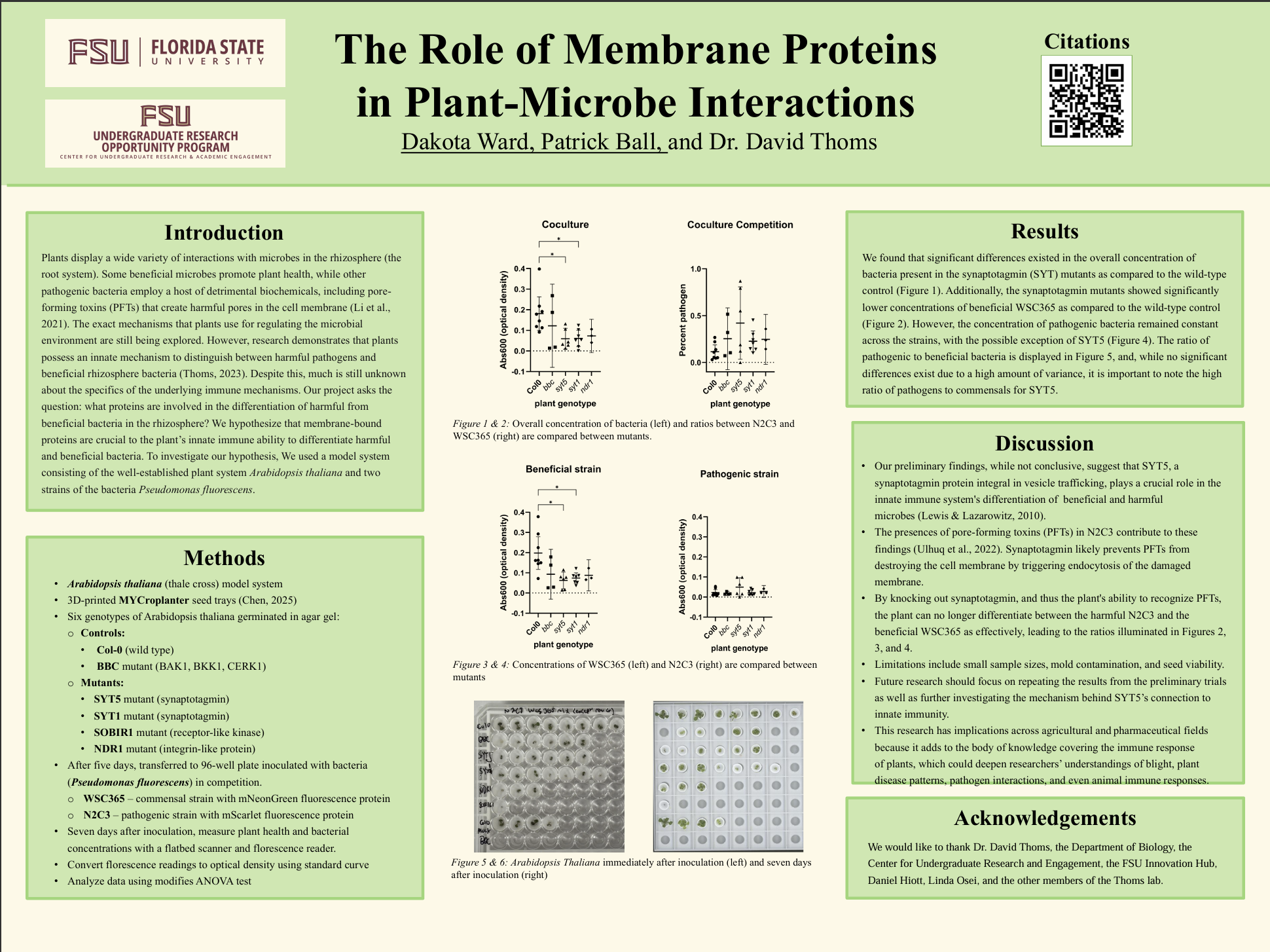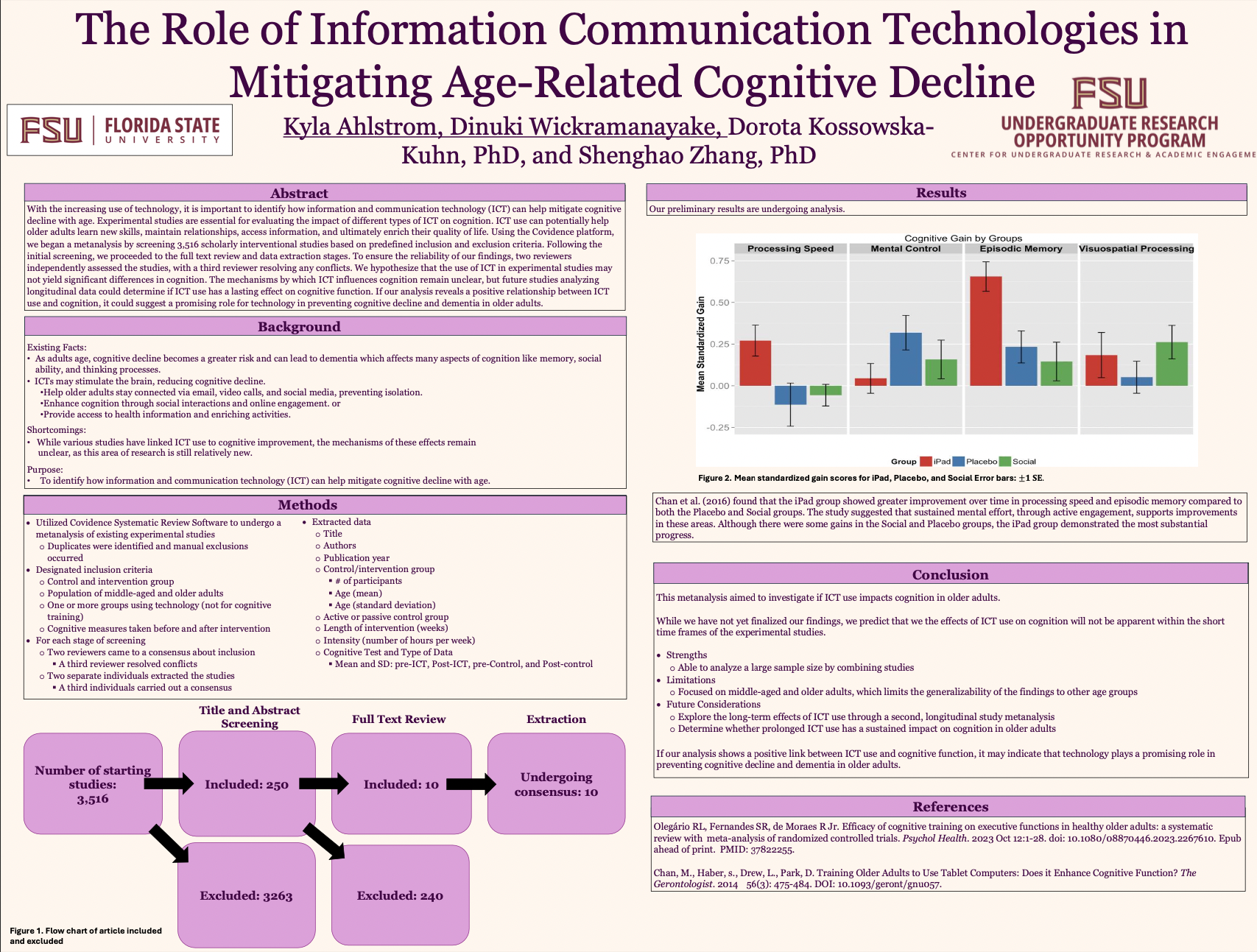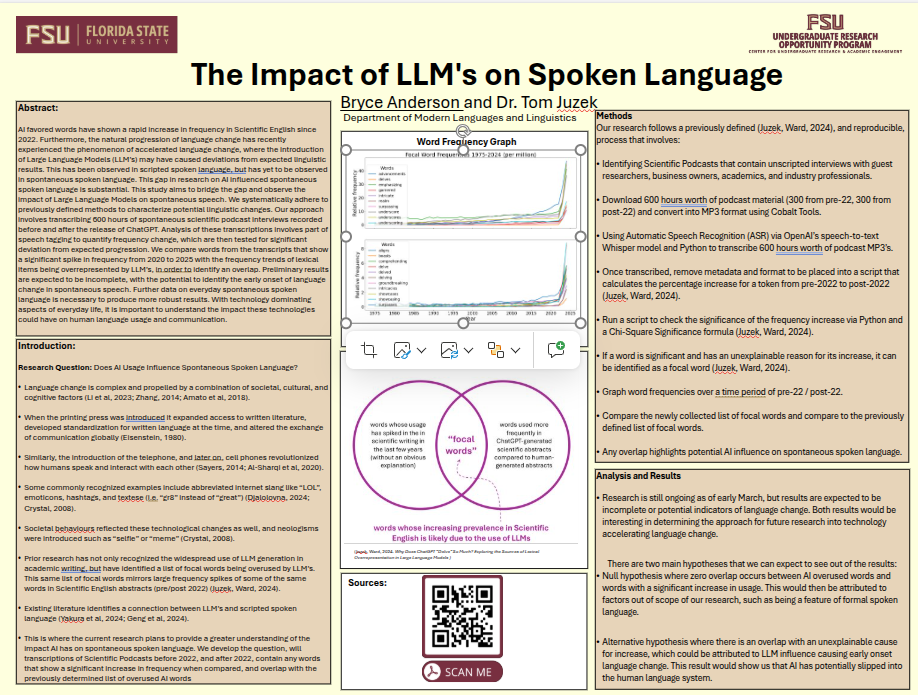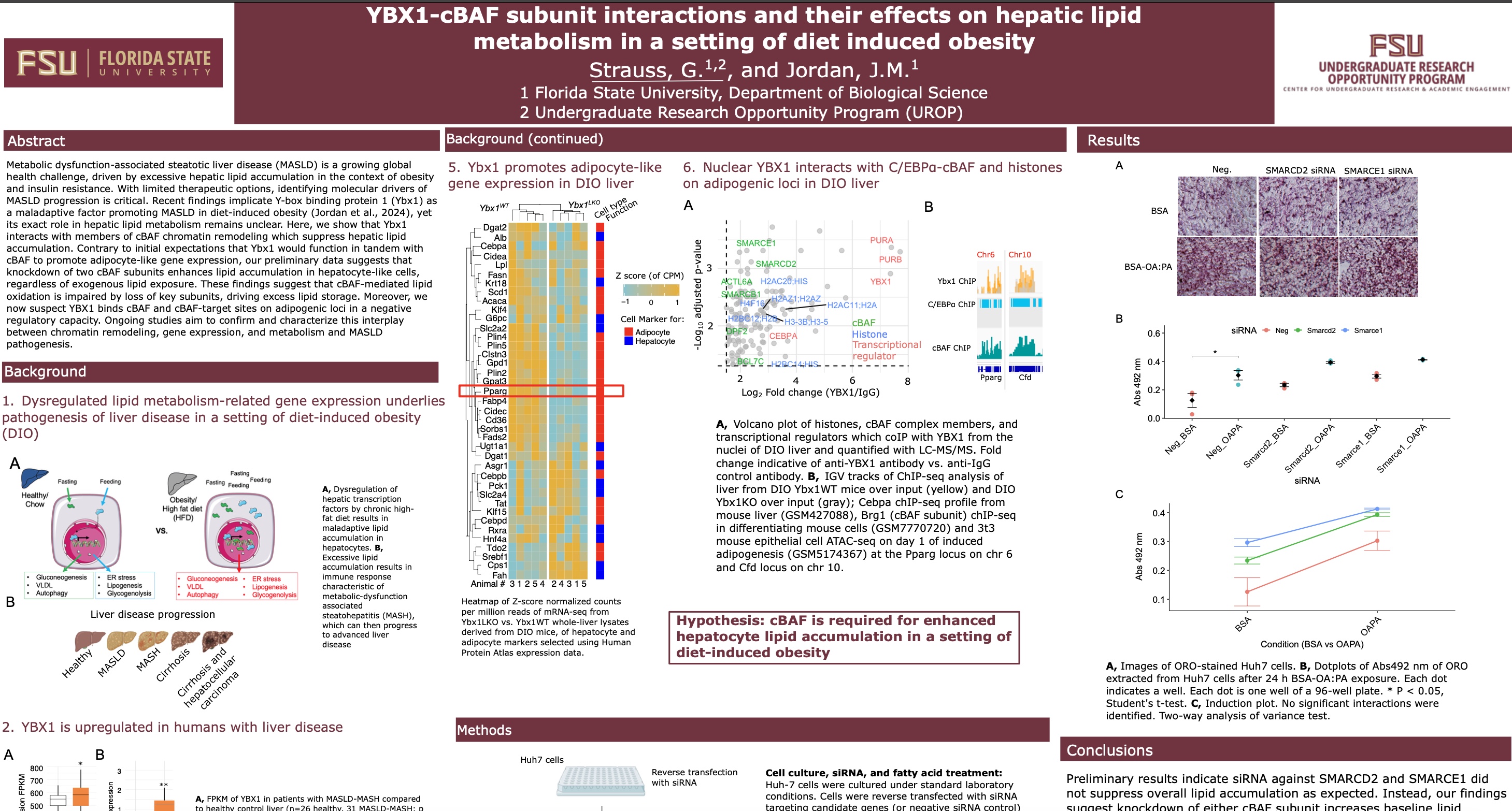Research Symposium
25th annual Undergraduate Research Symposium, April 1, 2025
Mary Youngberg Poster Session 1: 9:30 am - 10:30 am/ Poster #197

BIO
Hello, my name is Mary Youngberg, and I am a sophomore majoring in IMS: Pre-Clinical Professions. Born and raised in Rockaway Beach, NY, I’m pursuing a career as a Physician Assistant, driven by a passion for healthcare and helping others. I’ve also conducted research in maize genetics, focusing on how DNA motifs regulate gene function—a study that could lead to advances in crop development and sustainability. By combining my love for science and medicine, I hope to make a lasting impact both in healthcare and beyond.
Investigating the Functional Association of Genes Sharing Cis-Acting Motifs in Maize Using Bioinformatics and Gene Ontology Analysis
Authors: Mary Youngberg, Dr. Hank BassStudent Major: Pre-Clinical Professions
Mentor: Dr. Hank Bass
Mentor's Department: Department of Biological Sciences Mentor's College: Biological Sciences Co-Presenters: Becca Sayad
Abstract
The research hypothesis for our experiment is genes sharing cis-regulatory elements also share a biological function. We have hundreds of cis-regulatory elements (DNA motifs) in our model organism, maize (Zea mays), but none are assigned a biological function. To test our hypothesis, we carried out these steps: (1) intersected the DNA motif family with genes to create a list of genes for each motif and (2) used the gene list to conduct a Gene Ontology (GO) analysis with the AgriGO database. Gene ontologies, such as "development" or "disease response," indicate genetic pathways or biological functions. This research is important because the motifs may identify genes that respond to similar signals and environmental cues. Specifically, we first chose a motif family with at least 1000 locations (mode of action peaks of motifs). We obtained genomic locations for these motifs as BED files. We used the bioinformatics program, DeepTools Intersect, to generate a list of genes with each motif family. From this preliminary GO analysis, we found many of the motif-specific genes were enriched for certain pathways. For genes intersecting DNA motif family, we observed enrichment for GO categories: PROCESS cellular response to stimulus, PROCESS reproductive process, and PROCESS organelle organization. This indicates that dym63 regulates genes in these pathways. Among them, reproductive process is consistent with the motifs originating from developing earshoot, a reproductive tissue. Some GO categories appear to be detected too frequently. We are developing an independent test for significance to identify potential false positives from the GO analysis.
Keywords: genetics, maize, bioinformatics
25th annual Undergraduate Research Symposium, April 1, 2025
Ishani Kunala Poster Session 1: 9:30 am - 10:30 am/ Poster #111

BIO
Ishani is a first-year Presidential Scholar from Pembroke Pines, FL, pursuing a dual degree in Political Science and Finance with a minor in French. She is on the pre-law track with aspirations to attend law school abroad. Ishani is passionate about leadership, community engagement, and advocacy, which she actively pursues through her involvement on campus. She serves as the Vice President of the Broward, Landis, and Gilchrist residence hall complexes through IRHC for the 2024-2025 school year. Additionally, she is a member of the Presidential Scholars Outreach Board and Phi Alpha Delta, FSU’s pre-law fraternity, where she connects with fellow students interested in law and professional development.
Manufactured Happiness: The Cultural Construction of Fulfillment in Antebellum America
Authors: Ishani Kunala, William PerezStudent Major: Political Science, Finance
Mentor: William Perez
Mentor's Department: Religion Mentor's College: College of Arts and Sciences Co-Presenters:
Abstract
The concept of happiness has long been a subject of philosophical, religious, and
cultural exploration, often reflecting broader societal values and individual
aspirations. This research examines how happiness was defined and experienced by
women in Antebellum America, offering insight into the intersection of religious
beliefs, societal expectations, and personal fulfillment. Primary sources from the
North American Women’s Letters and Diaries database were analyzed to identify how
these women articulated happiness in their own words. A qualitative approach was
used to search for references to "happy" and "happiness," documenting significant
quotes along with their historical context. The study focuses on sources from 1800 to
1860 to ensure historical specificity.
Findings suggest that women expressed happiness through three main themes:
domesticity, religion, and, in some cases, independence. These themes were shaped
by a hypercognized belief that happiness could only be found in religious devotion
and domestic roles. This narrow understanding of happiness conditioned women to
accept these roles as the ultimate fulfillment, limiting their exploration of other forms
of happiness, such as independence. The study highlights how these rigid views of
happiness influenced women's experiences, shedding light on the complexities of
gender, faith, and autonomy in 19th-century America.
Keywords: Happiness Women Antebellum America Female
25th annual Undergraduate Research Symposium, April 1, 2025
Zachary Roz Poster Session 4: 3:00 pm - 4:00 pm/ Poster #210
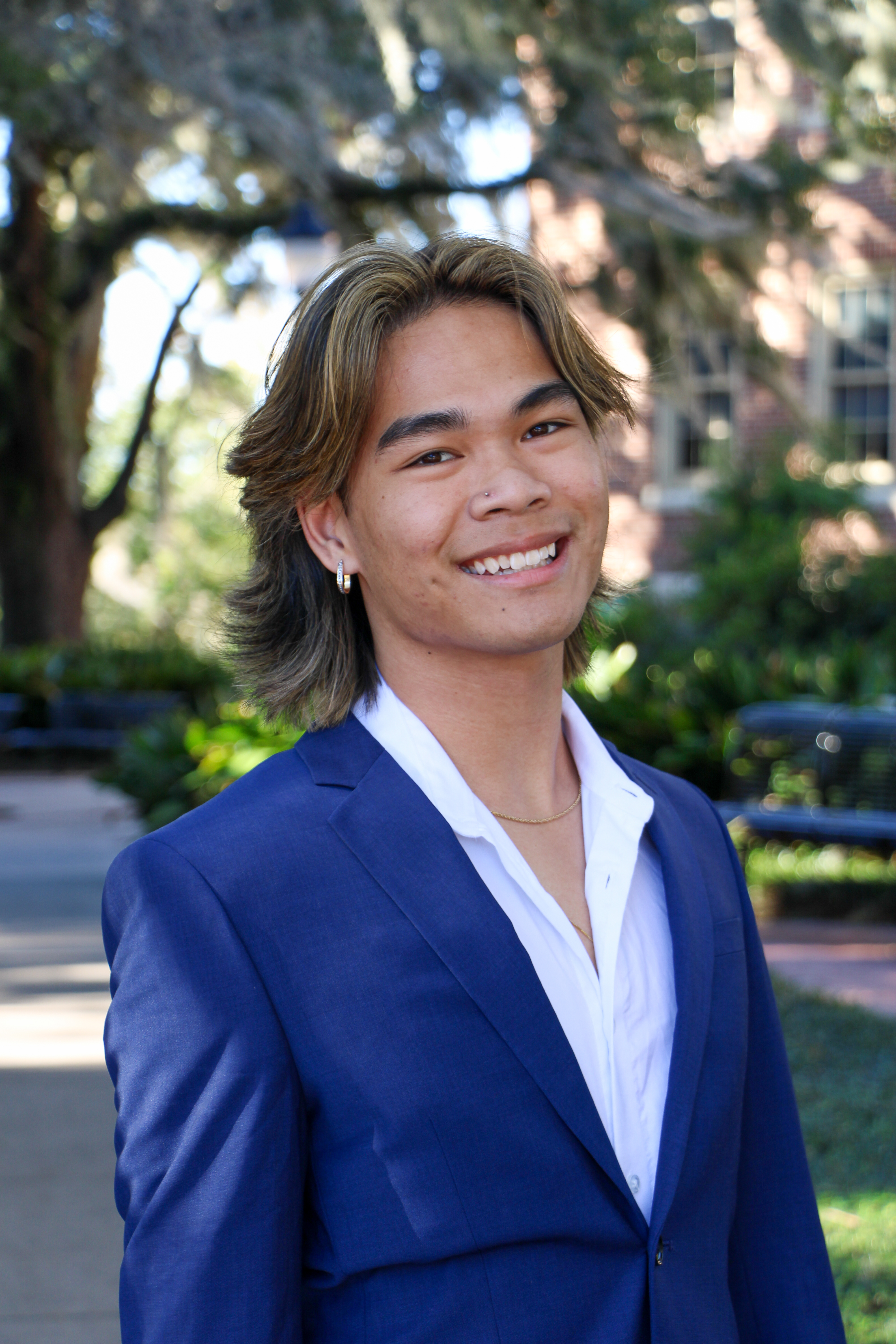
BIO
My name is Zachary Roz and I am a first-year undergraduate nursing major and presidential scholar from Orlando, Florida. I am interested in nursing research focusing specifically on pediatric nursing practices and topics that relate to the improvement of care for pediatric patients and their families. My goal is to one day become a pediatric nurse practitioner working in a critical care setting within a children's hospital.
Caregivers of Children With Special Healthcare Needs: Exploring the Relationships Between Parental Caregiving of CSHCN and the Use of Anti-Depressants
Authors: Zachary Roz, Dr. Mandy Bamber, PhD, RNStudent Major: Nursing, Child Development
Mentor: Dr. Mandy Bamber, PhD, RN
Mentor's Department: Faculty Mentor's College: College of Nursing Co-Presenters:
Abstract
Parental caregivers of children with special healthcare needs (CCSHCN) undergo constant daily stressors due to the prioritization of the ongoing medical and emotional needs of their children who they provide daily care for. This often leads to the caregivers overlooking their own personal needs. While researchers have investigated the effects of caregiving in this population on mood, little research exists exploring the incidence of diagnosed mood disorders and the use of antidepressants amongst caregivers. Therefore, our primary purpose of this study was to explore the use of antidepressants in parental caregivers of special needs children compared to parents of healthy typically developing children. We aimed to 1. Examine the differences in the use of antidepressants in parental caregivers of CSHCN and those with healthy, developing children, 2. Explore the relationships between parental demographics, self-care, depression, stress, anxiety and the use of antidepressants in caregivers, and 3. Explore the differences in child severity on the use of antidepressants in caregivers. A cross-sectional study was conducted with a convenience sample of 120 parent caregivers who self-reported diagnosed mood disorders, antidepressant used, sociodemographic information, completed the Depression, Stress, and Anxiety Scale (DASS), and the Mindful Self-care Scale (MSCS) questionnaires. We expect to find a positive association between the medical complexity of the pediatric patients and the caregiver’s use of antidepressants. Our findings may imply that the use of antidepressants is linked to depressive behaviors and high stress levels associated with caregiving of children with special healthcare needs.
Keywords: Nursing, Children, Caregivers
25th annual Undergraduate Research Symposium, April 1, 2025
Ernand Alzenor Poster Session 2: 10:45 am - 11:45 am/ Poster #107

BIO
Hello, my name is Ernand Alzenor. I was born and raised in Boca Raton, Florida. Currently, I have a great interest in polymer research. I like the potential of polymers in fields like water purification and materials science. My goal is to obtain a master’s degree in chemical engineering and pursue a career as a research scientist, contributing to advancements in sustainable materials and technology. Beyond academics, I enjoy playing basketball and chess in my free time, finding a balance between physical activity and strategic thinking. I aim to make meaningful contributions to scientific research in the future.
Selective Ion Transport Through Polymer Membranes
Authors: Ernand Alzenor, Kyoungmin KimStudent Major: Chemical Engineering
Mentor: Kyoungmin Kim
Mentor's Department: Biomedical and Chemical Engineering Mentor's College: FAMU-FSU College Of Engineering Co-Presenters:
Abstract
Developing cost-effective and eco-friendly water purification technologies remains challenging, especially in selectively separating metal species for water treatment and energy production. Effective separation is crucial for preserving metal resources, recovering valuable metals, and reducing pollution. Traditional methods like adsorption, precipitation, and extraction produce excessive sludge and sometimes fail to achieve complete metal removal. Cation exchange membranes (CEMs) provide a more efficient and sustainable alternative due to their high ion selectivity, allowing only positively charged ions to pass while blocking anions. Their advantages include high ionic conductivity, chemical stability, durability, and thermal resistance. This study investigates a polymer membrane subjected to cation exchange with sodium ions, focusing on water uptake and ionic conductivity. The exchange occurred in a sodium chloride solution for 24 hours and was confirmed by acid-base titration. Based on literature higher hydration is generally expected to enhance conductivity, the results agreed with past literature that greater hydration led to better electrochemical performance. The ionic charge density of sodium is one because sodium is a monovalent atom. The ionic charge density indicates sodium CEMs will have high ionic mobility and low hydration. A limitation of this study was membrane availability; both samples deteriorated from prolonged hydration, preventing permeability testing. Future work will focus on measuring ion permeability in CEMs to better understand ion transport mechanisms.
Keywords: Polymer Material Science
25th annual Undergraduate Research Symposium, April 1, 2025
Barock Assegid Poster Session 3: 1:45 pm - 2:45 pm/ Poster #58

BIO
I am Barock Assegid, a second-year Mechanical Engineering student at the FAMU-FSU College of Engineering from Palm Beach, Florida. My interests in Engineering include dynamic systems and aeronautics, with the eventual goal of working within the defense industry. Besides engineering, I enjoy reading, philosophy, and sports.
Hypersonic Flow Diagnostic of Boundary Layer Transition Length in a PSWT
Authors: Barock Assegid, Dr. Alexandre BergerStudent Major: Mechanical Engineering
Mentor: Dr. Alexandre Berger
Mentor's Department: Mechanical Engineering Mentor's College: FAMU-FSU College of Engineering Co-Presenters:
Abstract
This research investigates the transition from laminar to turbulent boundary layers in hypersonic flow, a critical phenomenon impacting high-speed vehicles' aerodynamic and thermal performance. Previous studies have established that second-mode instabilities—high-frequency acoustic waves—play a dominant role in destabilizing boundary layers under hypersonic conditions. The growth of these acoustic waves depends on the acoustic environment, resulting in varying transition lengths among wind tunnels. To characterize the acoustic environment of FAMU-FSU’s PolySonic Wind Tunnel (PSWT), amplification rates of these perturbations will be measured and compared with those in other facilities.
A seven-degree half-angle cone at zero angle-of-attack, designed using SolidWorks, will be tested in the PolySonic wind tunnel. The study intends to characterize the transition onset using pressure sensors and Schlieren imaging data. Signal analysis using Fourier transforms in Python will focus on identifying dominant frequencies associated with boundary layer perturbations.
By measuring the amplitude growth of second-mode instabilities and mapping transition lengths, this research seeks to validate theoretical models and characterize the acoustic environment within the specific conditions of the AME wind tunnel. The results are expected to enable boundary layer transition experiments to be performed with a measurable baseline. Transition studies aim to enhance understanding of hypersonic boundary layer dynamics and provide critical data for improving computational models. This work aims to inform the design of hypersonic vehicles by aiding in the prediction of transition points, thereby minimizing boundary layer-induced drag and thermal loads. Future extensions of the research will consider varied geometries and flow conditions to generalize findings.
Keywords: Aeronautics, Engineering, Hypersonic, Aerospace, Aerodynamics
25th annual Undergraduate Research Symposium, April 1, 2025
Olivia Sadler Poster Session 4: 3:00 pm - 4:00 pm/ Poster #170

BIO
Hello. My name is Olivia Sadler. I am currently a junior at Florida State University majoring in Classical Civilizations. I plan to continue my education in the field of Classics, with the goal of working in archaeology and museum studies.
I’m especially interested in how we can use material culture to better understand the past and share those stories with modern audiences. History, mythology, reading, and art have always been personal passions of mine, and they continue to shape both my academic and professional goals. I look forward to pursuing a career where I can help preserve and interpret cultural heritage for future generations.
Cataloging and Interpreting Bone Artifacts from the Roman Bathhouse at Cosa
Authors: Olivia Sadler, Dr Christina ChaStudent Major: Classical Civilizations
Mentor: Dr Christina Cha
Mentor's Department: Classics Mentor's College: Arts and Sciences Co-Presenters:
Abstract
This project focuses on the preparation of an on-site museum exhibition for the Roman bathhouse in the ancient city of Cosa, with particular attention to cataloging and interpreting artifacts made of bone. The aim is to expand public knowledge of Roman daily life by presenting objects through an anthropological lens, emphasizing their practical uses and cultural significance. Since the museum is located on site, the exhibition will provide visitors with a direct connection to the material history of the region.
My role in this project involves analyzing bone artifacts excavated at Cosa and comparing them with similar objects found at other sites. This comparative approach, supported by academic literature, ensures accurate identification and contextualization of the materials. The final product includes the classification of objects, detailed physical descriptions, and historical interpretations suitable for museum display. These descriptions will cover aspects such as material composition, function, and broader geographical significance.
Keywords: Cosa, Museum, Classics, Excavation
25th annual Undergraduate Research Symposium, April 1, 2025
Gabriel Diaz Poster Session 4: 3:00 pm - 4:00 pm/ Poster #213

BIO
Gabriel is a Criminology student with a double major in Interdisciplinary Social Science. His primary research interests are social causes and repercussions for crime and methods of crime prevention.
Modern Indicators of Historical Injustices: A Dataset of Structural Bias in the Policing of Racialized Violence in Sundown Towns
Authors: Gabriel Diaz, Jack MillsStudent Major: Criminology
Mentor: Jack Mills
Mentor's Department: Criminology Mentor's College: Florida State University Co-Presenters: Morgan Walker
Abstract
A substantial component of racism in American history manifests as residential segregation and exclusion. Yet, few works have explored the deep history of sundown towns—places that enforced the absolute exclusion of Black people and other marginalized groups. The research builds from the foundation of historical sociologist James Loewen, who identified more than 2,000 racially restrictive communities, exploring variation in intergroup violence. Specifically, the research examines hate crimes—offenses committed because of a victim’s perceived or actual identity—in these communities, compared to areas not identified by Loewen. There are three phases of analyses. First, the study compares sundown towns to other communities by the prevalence and frequency of hate crimes. While there are tests included for all hate crimes, there is a specific focus on offenses committed because of a victim’s racial identity. Second, the research validates these quantitative tests through qualitative accounts of direct or vicarious experiences of targeted violence/threat of violence, social prejudice, and official discrimination. Generally, these findings suggest a mismatch between the “official” and “people’s” stories of hate crimes in these historically racist communities. Third, in light of this disjuncture, it examines structural bias in American law enforcement’s reporting of hate crimes in racially exclusive communities relative to communities not identified in the original Loewen dataset. The results point to systematic omissions of hate crimes in towns with pasts of official exclusion through sundown ordinances and practices. This illustrates the long-lasting effects of racism on the community and place, signaling immediate attention from policymakers and academics.
Keywords: Hate crimes, police, discrimination, sundown town
25th annual Undergraduate Research Symposium, April 1, 2025
Sabrina Clark Poster Session 2: 10:45 am - 11:45 am/ Poster #236
BIO
I am a sophomore environmental engineering major from Orlando, Florida. I hope to do more research in the future and work towards creating a cleaner and safer environment.
Fluorotelomer Alcohol Permeation through Landfill Covers and Liners
Authors: Sabrina Clark, Youneng TangStudent Major: Environmental Engineering
Mentor: Youneng Tang
Mentor's Department: Civil and Environmental Engineering Mentor's College: FAMU-FSU College of Engineering Co-Presenters:
Abstract
Per- and Polyfluoroalkyl substances are extremely stable molecules, which makes them very useful for things like treating textiles and as protective coatings for packaging materials. Their use in a variety of consumer goods often leads them to end up in landfills. Landfills often produce leachate as water percolates through the waste while collecting contaminants from waste, which include PFAS, and then leaches out into the soil and groundwater. This is a serious environmental concern due to the bioaccumulative and potentially carcinogenic nature of these molecules. We aim to determine the permeability of volatile PFAS through high-density polyethylene(HDPE) membranes that are commonly used as landfill bottom liners. We will do this by testing the permeation of fluorotelomer alcohols (FTOHs) through a HDPE membrane over time at 4 different temperatures. We will use this experimental data to determine permeation, diffusion and partition coefficients, and breakthrough time using two mathematical models. This research will give us more insight into permeation risks of volatile PFAS and assess how protective HDPE lanfill liners are. This insight will be useful in efforts to keep both humans and wildlife protected from these chemicals.
Keywords: PFAS, Landfill liners, Permeation
25th annual Undergraduate Research Symposium, April 1, 2025
Emily Tully Poster Session 4: 3:00 pm - 4:00 pm/ Poster #51
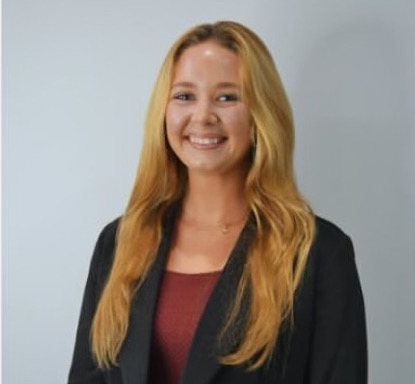
BIO
Emily Tully is a second year student from Long Island, New York. After finding her passion for Education and Public service at a young age, her desire to serve in the areas of curriculum development and higher education administration have only grown through her collegiate pursuits. Emily values leading a driven and well rounded lifestyle that allows her to grow, learn, and thrive so that she can be a leader, mentor, and driver of progress within her academic, professional, and social communities.
Alumni Engagement and Student Success through Shared Affinities
Authors: Emily Tully, Jacey DarrahStudent Major: Social Science Education and Political Science Dual Degrees
Mentor: Jacey Darrah
Mentor's Department: Alumni Association Mentor's College: Division of Undergraduate Studies Co-Presenters: Jasmeen Santos-Ramirez
Abstract
This research project aims to investigate the relationship between alumni engagement and student success at Florida State University. We investigated the reasons and methods behind alumni remaining connected to the university, and determined which student groups alumni are most likely to engage with. Over a five-month period, we collected qualitative data in interviews, conducted 40 interviews with students and 40 interviews with alumni. This consisted of collecting qualitative data on the involvement of each constituent at the university during or after graduation, based on the constituent we spoke to. The interviews were examined with our research mentor, Ms. Jacey Darrah, in one-on-one meetings to determine the correlation between different methods of participation as alumni, the spaces in which they were involved, and any limitations to participation. In addition, we received data from Undergraduate Studies (UGS) event surveys and UGS email communications. The project demonstrates that alumni who were heavily involved with affinity programming during their undergraduate years are more likely to remain active post-graduation, and similarly, engaged students are more likely to interact with alumni. The findings suggest that inviting more alumni to campus events and encouraging student participation in professional development organizations can broaden the university’s alumni base.
Keywords: alumni engagement, student success, affinity
25th annual Undergraduate Research Symposium, April 1, 2025
Carmen Escalera Poster Session 2: 10:45 am - 11:45 am/ Poster #87

BIO
I am a IMS Clinical Professions major on a pre medical route. I grew up in Cocoa Beach, Fl where I received my Associates Degree while still in high school. This process allowed me to explore my interests within the medical field, specifically orthopedic surgery and oncology. Research has also been an interest of mine, and having the opportunity to work in the Francis Lab has allowed me to explore the ideals of working in a lab and creating on my own projects. This is the first research lab I have worked in at Florida State and I plan on continuing in this lab for the rest of my time at FSU.
Construction and Validation of a Halo-tagged fluorescence HIV-1 particles for single virus punctate imaging inside living cells
Authors: Carmen Escalera, Ashwanth FrancisStudent Major: IMS Clinical Professions
Mentor: Ashwanth Francis
Mentor's Department: Biological Science Mentor's College: Florida State University Co-Presenters:
Abstract
A Halo-tag is a self-labeling protein tag used to study interactions and localization through fluorescence imaging. My UROP project was geared towards creating a Halo-tagged virus that would have the unique capabilities of fluorescing at two different wavelengths. Once the tagged virus is mixed with the cells, a microscope will enable the visualization of where the virus is and how it travels around the cell. To accomplish this goal I constructed a plasmid encoding for the Vpr-integrase-Halo tag (BruVIN-Halo) fusion protein, that when co-transfected with a viral genome encoding plasmids can become incorporated into virions. I evaluated the incorporation of the BruVIN-Halo, and its labeling by Janelia Fluorophore (JF646) by confocal microscopy. Image analysis showed a strong labeling of the viral BruVIN-Halo protein, which appeared as a bright puncta resistant to photobleaching over ~4000 iterations of imaging. In ongoing work, I am evaluating the effects of bruVIN-Halo tag incorporation on virus infection. Subsequently, I am to infect living Hela Cells and image the virus localization and trafficking in the nucleus. These experiments will help me accurately pinpoint the localization of HIV-1 inside different compartments of the mammalian cell. I also aim to explore stochastic labeling of the IN-Halo protein, which involves colabelling the virus with 2 fluorophores, and examine molecular changes to the virus architecture by fluorescence resonance energy transfer (FRET) imaging of HIV-1 infection.
Keywords: Virology, Halo-tag, fluorescence, HIV-1
25th annual Undergraduate Research Symposium, April 1, 2025
Stephanie Leon Poster Session 1: 9:30 am - 10:30 am/ Poster #251

BIO
Stephanie Leon is a first-year Presidential Scholar at Florida State University, majoring in Political Science. Originally from Homestead, Florida, she is a first-generation student and a proud member of the CARE program. Stephanie is passionate about service, advocacy, and social justice. She serves as the President of the Broward, Landis, and Gilchrist Hall Council and is a member of the Incoming Class Representatives Committee for the Presidential Scholars Program. Additionally, she is a participant in the Applied Politics and Policy Learning Experience. After completing her undergraduate studies, Stephanie hopes to attend law school to further her education and work towards creating meaningful change in the legal field.
The Forgotten Front: Prisoners and Patriots in Revolutionary St. Augustine (1780-1781)
Authors: Stephanie Leon, Benjamin GunterStudent Major: Political Science
Mentor: Benjamin Gunter
Mentor's Department: Communication Mentor's College: College of Communication and Information Co-Presenters:
Abstract
The American Revolution was not only a fight for independence but also a struggle over justice, loyalty, and national identity. While Patriots sought to break free from British rule, the Crown used imprisonment and exile as tools to suppress rebellion. This research examines the experiences of prisoners of war and exiled Patriots in St. Augustine, Florida, a critical yet often overlooked Loyalist refuge. As one of the few colonies that remained under British control, East Florida became both a prison for captured revolutionaries and a place of forced exile for Patriot leaders removed from their communities.
Drawing on letters, diaries, government records, and contemporary accounts, this study explores the conditions of imprisonment, the legal and political motivations for exile, and the broader implications of these measures on wartime justice and post-war reconciliation. It also investigates how displaced Patriots resisted, adapted, or reintegrated into American society during imprisonment and after the war. By revisiting these narratives, this research provides a deeper understanding of the Revolution’s civil war dynamics and highlights St. Augustine’s role in shaping early American concepts of justice, punishment, and national belonging.
Keywords: American Revolution, History, St. Augustine
25th annual Undergraduate Research Symposium, April 1, 2025
Samuel Isenberg Poster Session 2: 10:45 am - 11:45 am/ Poster #148

BIO
I grew up in Naples, Florida as part of a large family with two older brothers and a little sister. I always had an interest in psychology and this was only heightened by constantly talking to my dad, a psychology major himself, about various topics relating to psychology. Child psychology was always a keen interest for me, particularly because I was fascinated with how the brain develops and how we learn. Due to this, I hope to continue studying psychology and focus on education. I would like to do more research into this and pursue a master's degree as well as a PhD.
From First Impressions to Lasting Connections: Investigating Attraction and Relationship Success in Virtual-Speed-Dating
Authors: Samuel Isenberg, Isabella NapolesStudent Major: Psychology
Mentor: Isabella Napoles
Mentor's Department: Psychology Department Mentor's College: FSU College of Arts and Sciences Co-Presenters: Jason Zheng
Abstract
We seek to answer a few related questions: what factors best predict initial attraction and relationship formation? What predicts relationship maintenance and success over time? We also aim to create a comprehensive guide for others attempting a virtual speed-dating study. This is relevant today both to scholars, who may want to replicate this unconventional method, as well as those looking for a partner, who may be able to watch for certain characteristics in partners for potential relationship success. To conduct this study, participants volunteer and take an eligibility survey. If they are eligible, they are then scheduled for an event. After this, a pre-event survey is sent out providing the researchers with personality information. After this, a Zoom speed date event occurs, and participants’ preferences are recorded throughout it. Following this, a 30-minute first date is conducted via Zoom between mutual matches within seven days. After this, the participants are allowed to meet in person. Surveys are sent to them to further examine the success of their relationship over time. The study is ongoing, but we are collecting data on numerous constructs in a longitudinal design in an effort to obtain a large database to improve the scientific understanding of attraction, relationship formation and dissolution, and same-sex competition for mates.
Keywords: Attraction, Dating, First Impression, Impression, Initial attraction
25th annual Undergraduate Research Symposium, April 1, 2025
Anna Kuntz Poster Session 4: 3:00 pm - 4:00 pm/ Poster #20
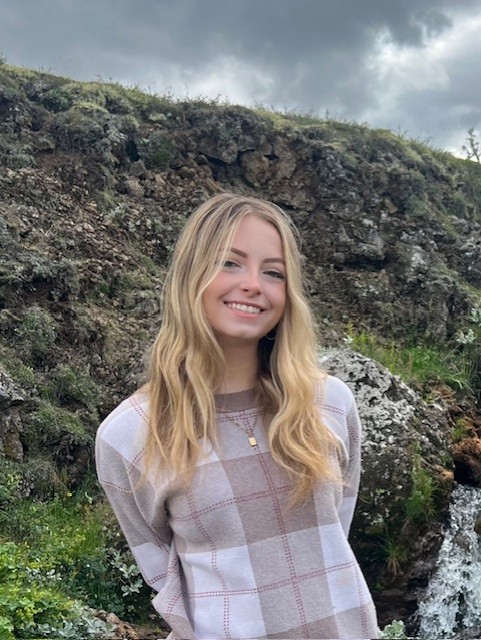
BIO
I am a 2nd year student from Tallahassee Florida. I am majoring in biology and double minoring in psychology and chemistry with the goal of going to dental school.
Morphological Analysis Pathway for Reading
Authors: Anna Kuntz, Carla WoodStudent Major: Biological Sciences
Mentor: Carla Wood
Mentor's Department: College of Communication and Information Mentor's College: Florida State University Co-Presenters:
Abstract
This study hopes to examine the effectiveness of the Morphological Analysis Pathway to Reading (MAP-R) as a way to improve literacy in at-risk children such as bilingual or hard of hearing students. Language fluency is critical for students, especially at a young age, so it is important to investigate what methods could be used to increase literacy for students who may be more prone to struggle with language. Data from students was collected, such as the number of words and percentage of different categories of words. This data gives the ability to track students’ progress using MAP-R. Future studies in this field could include altering the program to see further how students learn best.
Keywords: literacy fluency speech
25th annual Undergraduate Research Symposium, April 1, 2025
Emily Hernandez Poster Session 4: 3:00 pm - 4:00 pm/ Poster #133

BIO
Emily Hernandez is a Finance major at Florida State University interested in pursuing a dual-degree in Political Science. She is from Miami, Florida and has plans to attend law school. She is the outreach coordinator for the Cuban American Student Association, a founding member of Kappa Alpha Pi fraternity on campus, and a legal translator for Voces Unidas: Multilingual Initiative for Farmworker and Immigrant Advocacy. Emily's research interests are gender-inclusive language, particularly in Latin America. During her free time, she likes to try new restaurants, read, and paint.
The Progress of Spanish Inclusive Language in Latin America
Authors: Emily Hernandez, Adriana Gordillo BarahonaStudent Major: Finance
Mentor: Adriana Gordillo Barahona
Mentor's Department: Modern Languages Mentor's College: College of Arts and Sciences Co-Presenters: Megan Madhosingh
Abstract
Spanish, as a gendered language, assigns words a grammatical gender, typically male or female, reinforcing a binary understanding of gender. This structure reflects cultural norms that assume only two genders, making it difficult for nonbinary and transgender individuals to be accurately represented in language. Language plays a crucial role in shaping societal perceptions of gender, as seen in the ways that female associated terms often carry negative connotations or in the lack of gender neutral options for nonbinary individuals. Recent efforts to create inclusive Spanish terms, such as the use of "-e" and "-x" morphemes, have sparked discussion and debate, particularly in Spanish-speaking countries like Colombia and Argentina. However, there are gaps in existing research regarding its adoption and perception within Hispanic communities. While some research explores how inclusive language is received in Spain, there is less information on how it is used in Latin American countries, where cultural and political landscapes differ. Colombia and Argentina, in particular, have distinct histories with gender rights and language reform, making them key locations for understanding the implementation of neutral language. The purpose of this research is to investigate the use and acceptance of inclusive language in Spanish, specifically focusing on the "-e" and "-x" morphemes within the Hispanic populations of Colombia and Argentina. By studying how people in these countries use and respond to inclusive language, this research seeks to understand whether linguistic change is actively taking place and how it correlates with societal attitudes toward gender inclusivity.
Keywords: Spanish, Gender, Inclusive
25th annual Undergraduate Research Symposium, April 1, 2025
Onyinye Onyia Poster Session 3: 1:45 pm - 2:45 pm/ Poster #220
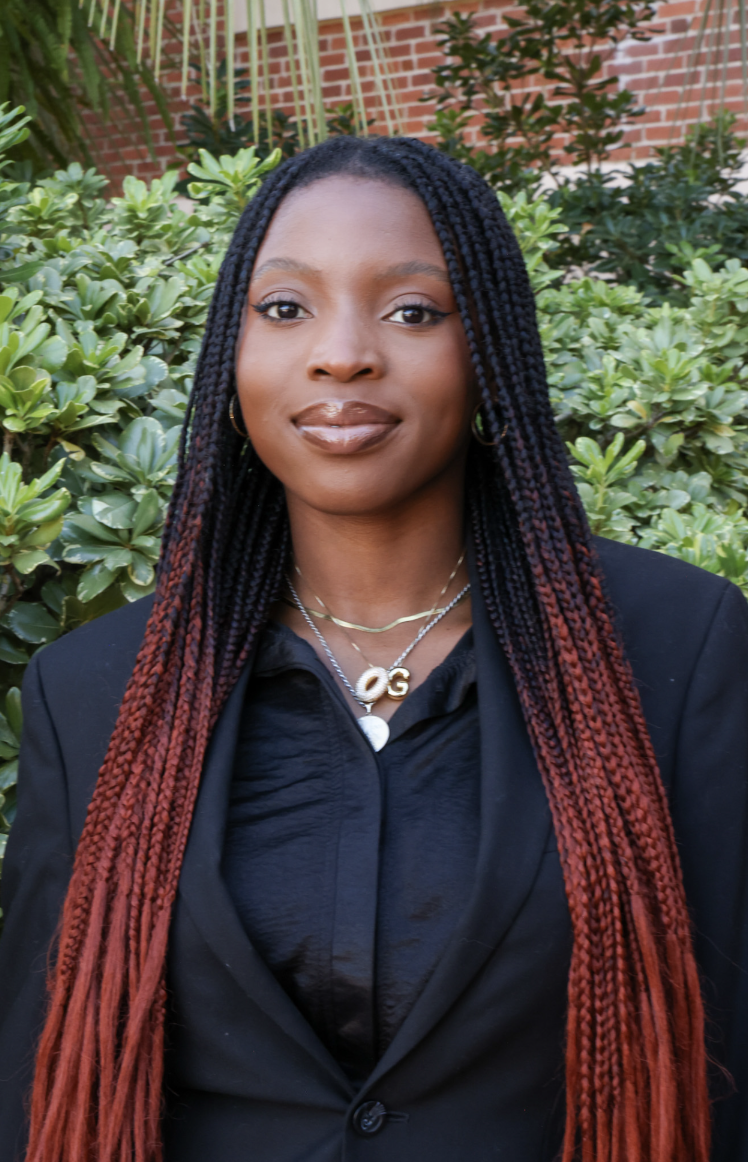
BIO
Hello, My name is Onyinye Onyia! I am a sophomore studying biology on the pre-med track!
Investigating the effect of RNAi knockdown of pgl-1 and ppw-2 in C. elegans
Authors: Onyinye Onyia, Amy WebsterStudent Major: Biology
Mentor: Amy Webster
Mentor's Department: Department of Biological Science Mentor's College: College of Arts and Sciences Co-Presenters:
Abstract
Genetically identical individuals can exhibit differences in their traits; however, the mechanisms underlying this phenomenon remain obscure. Using C. elegans, a roundworm commonly used as a model organism for biological research, we can create genetically identical individuals and use these individuals to test the influence of gene expression differences on traits of interest. Previous research has shown that variation in gene expression across individuals is associated with differences in reproductive traits. To test whether these genes are causal to affect reproduction in C. elegans, I am using RNAi to reduce mRNA expression and score reproductive traits. I am studying two genes of interest, pgl-1 and ppw-2. Preliminary results indicate that pgl-1 knockdown reduces progeny production, suggesting that pgl-1 function is typically required for normal progeny production. In contrast, ppw-2 does not appear to have an effect on progeny production in this experiment. Continued experimentation will further elucidate the role of these genes and others in C. elegans reproduction.
Keywords: genetics, c-elegans, DNA, RNAi, reproduction
25th annual Undergraduate Research Symposium, April 1, 2025
Dakota Ward Poster Session 4: 3:00 pm - 4:00 pm/ Poster #245
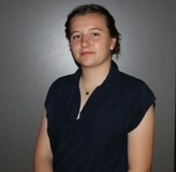
BIO
Dakota Ward is an FSU freshman majoring in biological sciences with a minor in math. She hails from Johnson City, Tennessee, although she grew up across the world in Haiti. Her research interests include microbiology, epidemiology, and health equity, and she is interested in pursuing a career in medicine, public health, or environmental protection.
The Role of Membrane Proteins in Plant-Microbe Interactions.
Authors: Dakota Ward, Dr. David ThomsStudent Major: Biological Sciences
Mentor: Dr. David Thoms
Mentor's Department: Biology Mentor's College: Arts and Sciences Co-Presenters: Patrick Ball
Abstract
Plants display a wide variety of interactions with microbes in the rhizosphere. Some beneficial microbes promote plant health, while pathogenic bacteria employ a host of detrimental biochemicals, including pore-forming toxins (PFTs), that create harmful pores in the cell membrane. The exact mechanisms that plants use for regulating the microbial environment are still being explored. However, research demonstrates that plants possess an innate mechanism to distinguish between harmful pathogens and beneficial rhizosphere bacteria. Despite this, much is still unknown about the specifics of the underlying immune mechanisms. Our project asks the question: what proteins are involved in the differentiation of harmful and beneficial bacteria in the rhizosphere? We hypothesize that membrane repair proteins are crucial to the plant’s innate immune ability to differentiate harmful and beneficial bacteria. To investigate our hypothesis, we used a model system consisting of the well-established plant system Arabidopsis thaliana and two strains of the bacteria Pseudomonas fluorescens: commensal WSC365 and pathogenic N2C3. Our preliminary results suggest that mutants with impaired Synaptotagmin-5, a membrane repair protein, may decrease the plant’s ability to differentiate harmful and beneficial bacteria. The low sample size and high variation in our data means that our results are not conclusive, so more trials should be run. However, these preliminary results are a promising indicator that Synaptotagmin-5 and the membrane repair process are involved in the plant’s innate immune response.
Keywords: Bacteria, Plant, Immune response
25th annual Undergraduate Research Symposium, April 1, 2025
Dinuki Wickramanayake Poster Session 4: 3:00 pm - 4:00 pm/ Poster #8
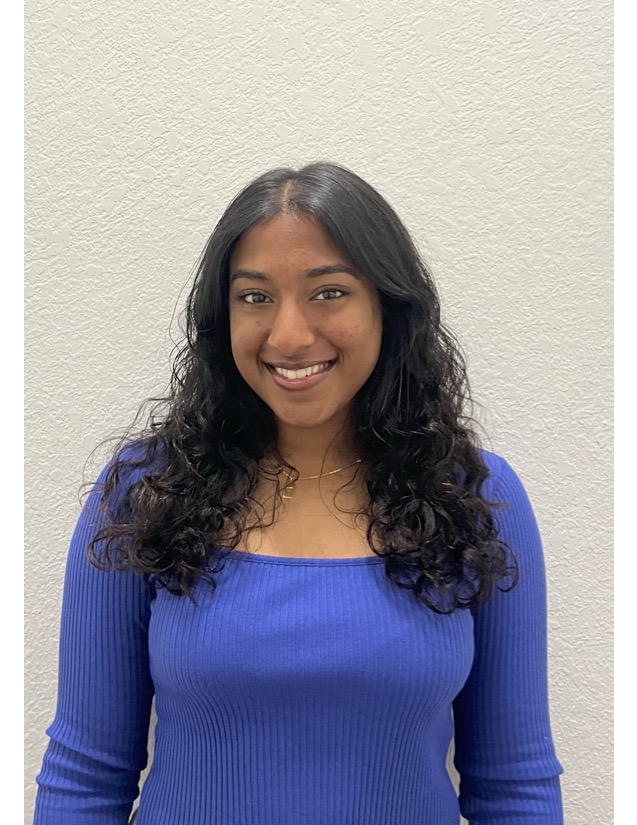
BIO
Hi! My name is Dinuki Wickramanayake, and I am from Spanish Fort, Alabama. I am currently a second-year student majoring in Public Health on the pre-Physician Assistant track. I work as a medical assistant at Tallahassee Memorial Hospital, and I am passionate about researching Alzheimer's disease and health disparities within underserved populations.
The Role of Information Communication Technologies in Mitigating Age-Related Cognitive Decline
Authors: Dinuki Wickramanayake, Dorota Kossowska-KuhnStudent Major: Public Health
Mentor: Dorota Kossowska-Kuhn
Mentor's Department: Department of Psychology Mentor's College: College of Arts and Sciences Co-Presenters: Kyla Ahlstrom
Abstract
With the increasing use of technology, it is important to identify how information and communication technology (ICT) can help mitigate cognitive decline with age. Experimental studies are essential for evaluating the impact of different types of ICT on cognition. ICT use can potentially help older adults learn new skills, maintain relationships, access information, and ultimately enrich their quality of life. Using the Covidence platform, we began a metanalysis by screening 3,516 scholarly interventional studies based on predefined inclusion and exclusion criteria. Following the initial screening, we proceeded to the full-text review and data extraction stages. To ensure the reliability of our findings, two reviewers independently assessed the studies, with a third reviewer resolving any conflicts. We hypothesize that the use of ICT in experimental studies may not yield significant differences in cognition. The mechanisms by which ICT influences cognition remain unclear, but future studies analyzing longitudinal data could determine if ICT use has a lasting effect on cognitive function. If our analysis reveals a positive relationship between ICT use and cognition, it could suggest a promising role for technology in preventing cognitive decline and dementia in older adults.
Keywords: Cognition, Technology, Dementia
25th annual Undergraduate Research Symposium, April 1, 2025
Bryce Anderson Poster Session 3: 1:45 pm - 2:45 pm/ Poster #45

BIO
Bryce Anderson is a junior at Florida State University, studying Computer Science and International Affairs. As a member of the Undergraduate Research Opportunity Program (UROP), Bryce is engaged in research exploring the influence of artificial intelligence on language, focusing on its impact on spoken language.
The Impact of LLM's on Spoken Language
Authors: Bryce Anderson, Dr. Tom JuzekStudent Major: Computer Science
Mentor: Dr. Tom Juzek
Mentor's Department: Department of Modern Languages and Linguistics Mentor's College: College of Arts and Sciences Co-Presenters:
Abstract
AI favored words have shown a rapid increase in frequency in Scientific English since 2022. Furthermore, the natural progression of language change has recently experienced the phenomenon of accelerated language change, where the introduction of Large Language Models (LLM’s) may have caused deviations from expected linguistic results. This has been observed in scripted spoken language, but has yet to be observed in spontaneous spoken language. This gap in research on AI influenced spontaneous spoken language is substantial. This study aims to bridge the gap and observe the impact of Large Language Models on spontaneous speech. We systematically adhere to previously defined methods to characterize potential linguistic changes. Our approach involves transcribing 600 hours of spontaneous scientific podcast interviews recorded before and after the release of ChatGPT. Analysis of these transcriptions involves part of speech tagging to quantify frequency change, which are then tested for significant deviation from expected progression. We compare words from the transcripts that show a significant spike in frequency from 2020 to 2025 with the frequency trends of lexical items being overrepresented by LLM’s, in order to identify an overlap. Preliminary results are expected to be incomplete, with the potential to identify the early onset of language change in spontaneous speech. Further data on everyday spontaneous spoken language is necessary to produce more robust results. With technology dominating aspects of everyday life, it is important to understand the impact these technologies could have on human language usage and communication.
Keywords: AI, Linguistics, Scientific Computing, Language Change, Artificial Intelligence
25th annual Undergraduate Research Symposium, April 1, 2025
Sandra O'Connell Poster Session 3: 1:45 pm - 2:45 pm/ Poster #259

BIO
Sandra O’Connell is a second-year undergraduate student pursuing a major in Spanish with a minor in Italian. Sandra’s passion for studying languages and their properties aligns with her current research assistantship on language contact. She plans to continue research beyond her undergraduate career and aims to become an ESL or foreign language instructor in the future.
Linguistic Convergence: Linguistic Outcomes of Language Contact Between Quechua and Spanish in Argentina
Authors: Sandra O'Connell, Dr. Antje MuntendamStudent Major: Spanish
Mentor: Dr. Antje Muntendam
Mentor's Department: Department of Modern Languages and Linguistics Mentor's College: College of Arts and Sciences Co-Presenters: Daniel Abrill, Andrea Mase
Abstract
This project intends to study the linguistic outcome of language contact between Quechua and Spanish in Argentina. When Spanish speakers ask yes-no questions, they use a rising intonation, while Quechua uses a falling intonation and the marker -chu. However, due to centuries of intense contact between the two languages, bilingual Quechua-Spanish speakers may be accustomed to using intonation in both languages or in neither. Thus, the question this project seeks to answer is what intonation bilinguals and monolinguals utilize in Santiago del Estero, Argentina. For this research project, audio samples were collected from this region from 26 bilingual Quechua-Spanish speakers and 15 monolingual Spanish speakers in which the participants were asked to play a card game where they would ask each other yes/no- questions. As research assistants, we analyzed these audio samples in the platform Praat to view the type of intonation. The results we found so far reveal that most bilingual speakers tend to continue to use rising intonation in Spanish at the end of the questions, although there are some differences between monolinguals and bilinguals in nuclear pitch accents (i.e., the tone on the stressed syllable of the last word). In Quechua, most speakers do not use the marker -chu and use a rising intonation as in Spanish instead. Variation among participants is found, which can be explained based on language use and language attitudes. This study furthers bilingualism research in Argentina, which is underexplored, and adds onto existing theories on language evolution and effects of language contact.
Keywords: Language Contact, Linguistic Outcomes, Intonation, Quechua, Spanish
25th annual Undergraduate Research Symposium, April 1, 2025
Greg Strauss Poster Session 4: 3:00 pm - 4:00 pm/ Poster #79
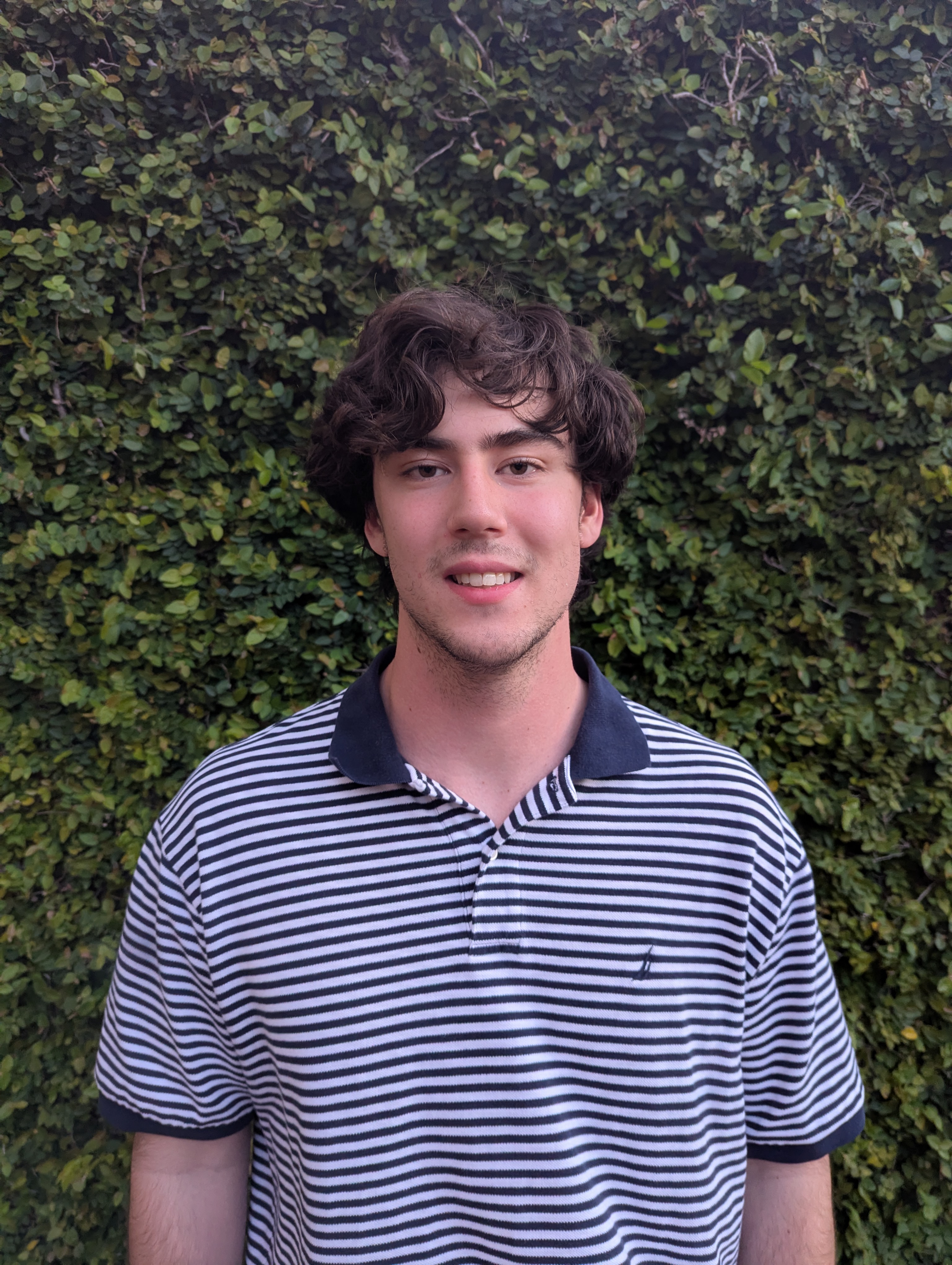
BIO
My name is Greg Strauss; I am a sophomore from St. Louis, Missouri receiving a double major in chemistry and Japanese. I plan to pursue a doctorate in chemistry and eventually work in the pharmaceutical industry researching medicinal synthesis methods.
YBX1-cBAF subunit interactions and their effects on hepatic lipid metabolism in a setting of diet induced obesity
Authors: Greg Strauss, Dr. James JordanStudent Major: Chemistry and Japanese
Mentor: Dr. James Jordan
Mentor's Department: Biology Mentor's College: Arts and Sciences Co-Presenters:
Abstract
Metabolic dysfunction-associated steatotic liver disease (MASLD) is a growing global
health challenge, driven by excessive hepatic lipid accumulation in the context of obesity
and insulin resistance. With limited therapeutic options, identifying molecular drivers of
MASLD progression is critical. Recent findings implicate Y-box binding protein 1 (Ybx1) as
a maladaptive factor promoting MASLD in diet-induced obesity (Jordan et al., 2024), yet
its exact role in hepatic lipid metabolism remains unclear. Here, we show that Ybx1
interacts with members of cBAF chromatin remodeling which suppress hepatic lipid
accumulation. Contrary to initial expectations that Ybx1 would function in tandem with
cBAF to promote adipocyte-like gene expression, our preliminary data suggests that
knockdown of two cBAF subunits enhances lipid accumulation in hepatocyte-like cells,
regardless of exogenous lipid exposure. These findings suggest that cBAF-mediated lipid
oxidation is impaired by loss of key subunits, driving excess lipid storage. Moreover, we
now suspect YBX1 binds cBAF and cBAF-target sites on adipogenic loci in a negative
regulatory capacity. Ongoing studies aim to confirm and characterize this interplay
between chromatin remodeling, gene expression, and metabolism and MASLD.
Keywords: YBX1, Biology, Genetics


